Vol. 72, No. 4 (2023)
2023-02-20
GENERAL
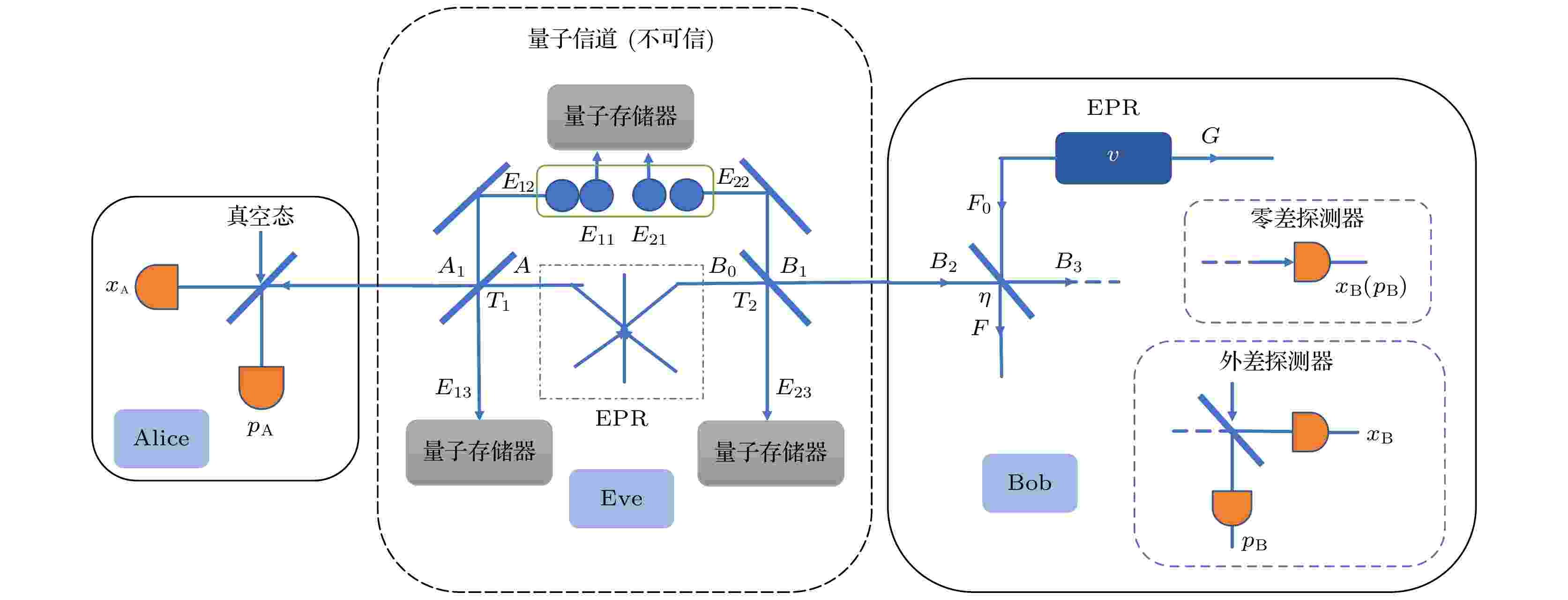
2023, 72 (4): 040301.
doi:10.7498/aps.72.20221902
Abstract +
In a practical quantum communication system, the security of signal source of continuous-variable quantum key distribution may be jeopardized due to device flaws and hidden attacks. In this paper, an improved scheme for Gaussian-modulated continuous-variable quantum key distribution based on an untrusted entangled source is proposed. In particular, the entanglement source is placed in an untrusted quantum channel to simulate that it is controlled by an eavesdropper, thereby verifying the security of Gaussian-modulated continuous-variable quantum key distribution in a complex environment. This work in detail analyzes the influence of untrusted entanglement source on practical Gaussian-modulated continuous-variable quantum key distribution system, and the numerical simulation shows that the performance of Gaussian-modulated continuous-variable quantum key distribution will dramatically decrease once the entanglement source has moved out of the sender, and it will slightly rise as the untrusted entanglement source slowly moves away from the sender. This paper further introduces two kinds of optical amplifiers, which are phase-sensitive amplifier and phase-insensitive amplifier, to compensate for the imperfection of the coherent detector. These amplifiers are beneficial to enhancing the quantum efficiency of the receiver’s detector. Specifically, the security key rate of Gaussian-modulated continuous-variable quantum key distribution with homodyne detection can be well improved by phase-sensitive amplifier, and the security key rate of Gaussian-modulated continuous-variable quantum key distribution with heterodyne detection can be well improved by phase-insensitive amplifier. To summary, this paper proposes a scheme for Gaussian-modulated continuous-variable quantum key distribution with untrusted entanglement source, experimental results show that the proposed scheme can generate secure quantum keys even if the Gaussian entanglement source is untrusted, and the two optical amplifiers can effectively improve the quantum efficiency of the detector at the receiver. This work aims to promote the practical process of the Gaussian-modulated continuous-variable quantum key distribution system and provide theoretical guidance for the practical implementation and application of the Gaussian-modulated continuous-variable quantum key distribution system.
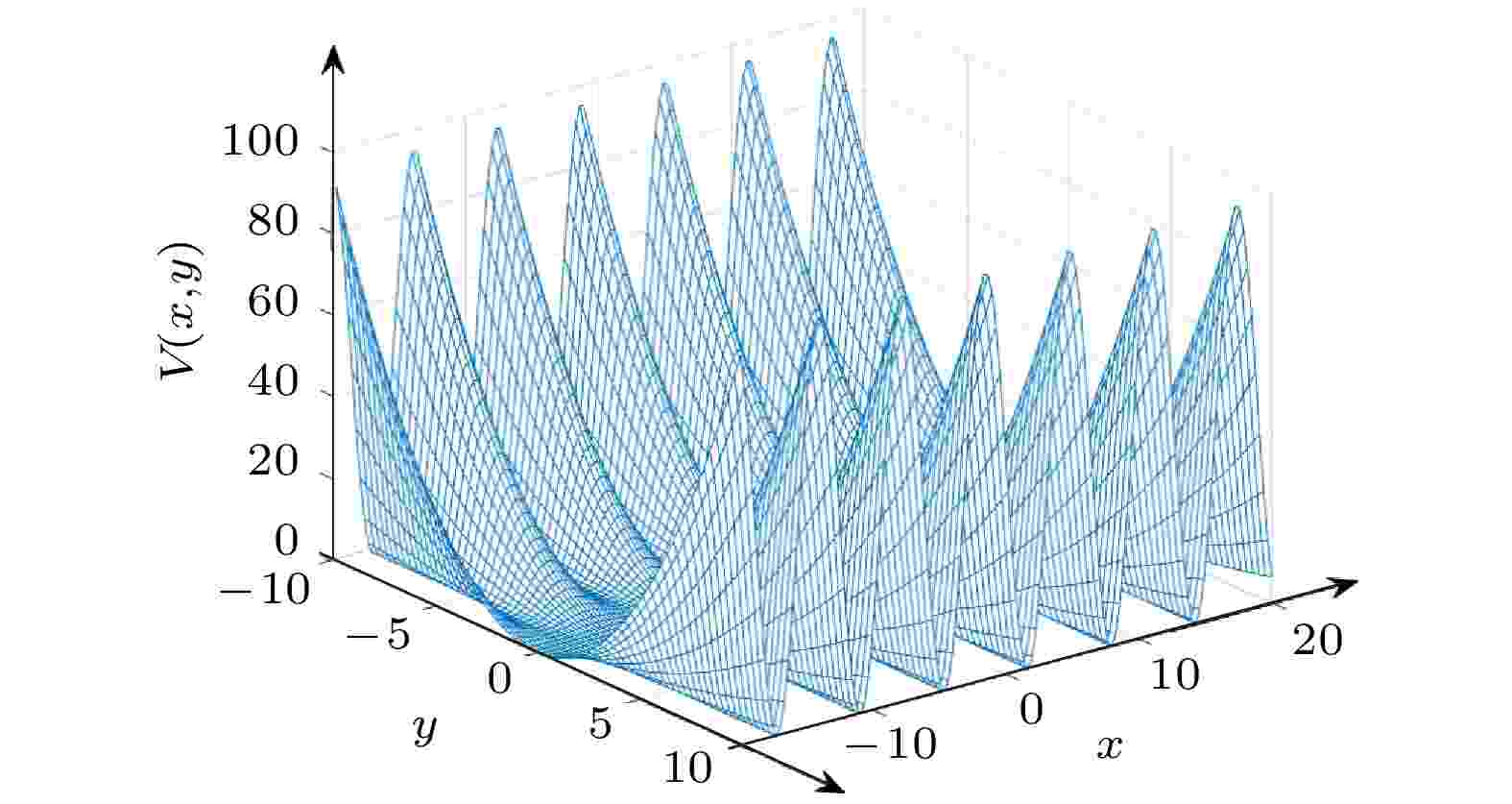
EDITOR'S SUGGESTION
Directional transport of two-dimensional coupled Brownian particles subjected to nonconserved forces
2023, 72 (4): 040501.
doi:10.7498/aps.72.20221741
Abstract +
ATOMIC AND MOLECULAR PHYSICS
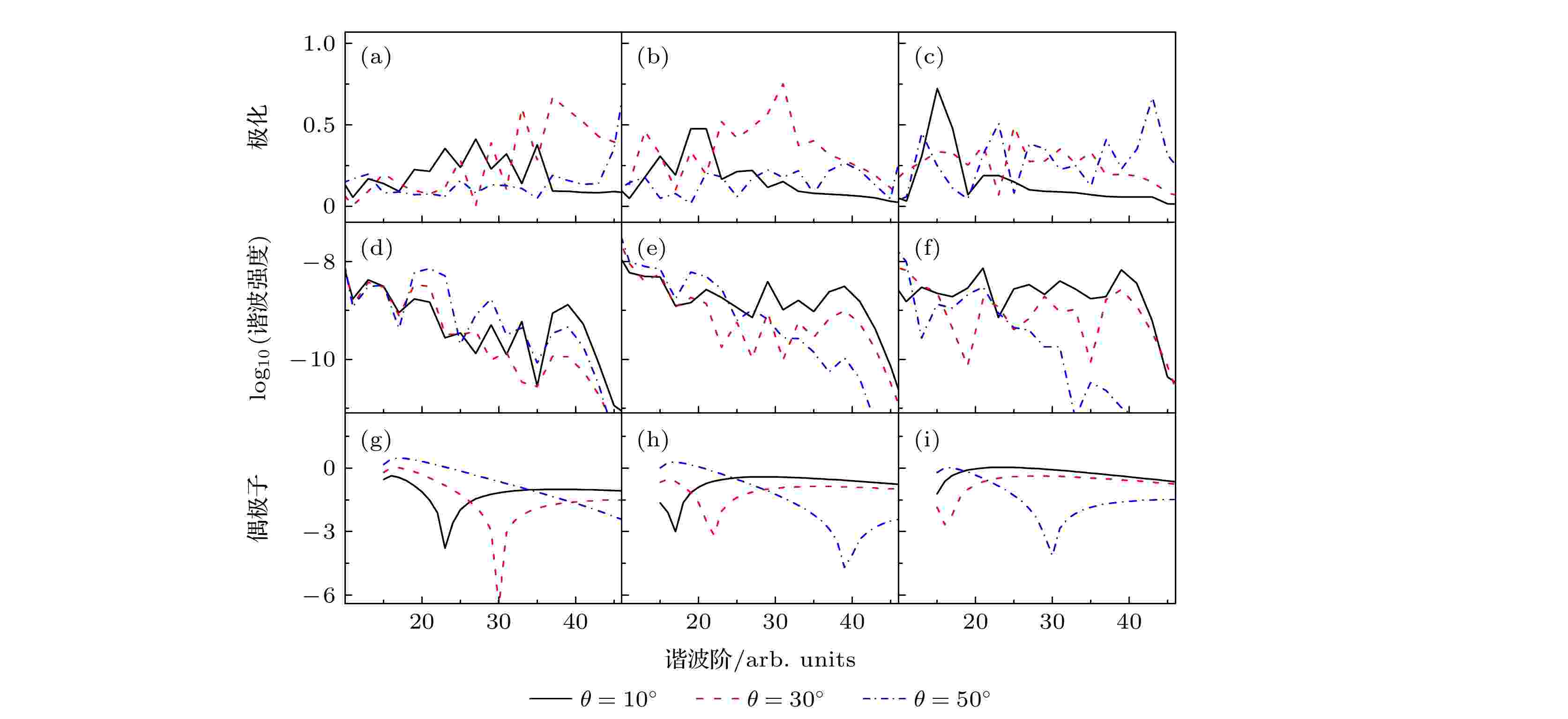
2023, 72 (4): 043101.
doi:10.7498/aps.72.20221946
Abstract +
Ellipticity properties of high-order harmonic generation (HHG) from symmetric molecules
$ {\text{H}}_{\text{2}}^ + $
in strong and short wavelength (less than 800nm) laser fields are numerically investigated. In this study, the ellipticity of harmonic is compared with the corresponding harmonic spectrum and dipole, and the calculation results are analyzed and the results obtained at different laser intensities, different laser wavelengths, different internuclear distances and different orientation angles are compared with each other. Our numerical simulations show that the influences of laser intensity, laser wavelength, internuclear distance and orientation angle on the ellipticity of harmonic are different. Especially in a two-center interference region, the excited state plays an important role in the HHG, but the effects of the excited state on the ellipticity of harmonic are different at different orientation angles. Further analysis shows that these different effects are due to the influence of the excited state on the harmonic yield. Using the numerical scheme, it is determined that in the two-center interference region, the excited state plays an important role in the parallel harmonic spectrum, while the effects of the excited state on the perpendicular harmonics at different angles are all very small, which results in different phase differences between the accurate harmonic spectrum and the harmonic spectrum only returning to the ground state. Overall, the relative yields of the accurate perpendicular harmonics are lower (higher) than those of the accurate parallel harmonics, but the intensities of the perpendicular harmonics, which only return to the ground state, are comparable to (or farther away from) those of the parallel harmonics which are only to return to ground state in the two-center interference regions. Therefore, the small (large) intensity ratio between the accurate perpendicular harmonic and accurate parallel harmonic can be attributed to the contributions of the excited state to harmonics. Then we can conclude that the harmonic spectra that only go back to the ground state show high (small) ellipticity, whereas the accurate harmonic spectra show small (high) ellipticity, resulting in a strong angle dependence of the influence of the excited state on the ellipticity of harmonic. In addition, in the high-order harmonic plateau region, the relative yields of harmonics can be well predicted by the corresponding dipoles, indicating the applicability of tunneling pictures and plane wave approximation in the strong and short-wave laser fields. When the ellipticity of harmonic occurs in the interference region due to the two-center characteristics of the symmetric potential, the results show that the polarization measurement can also be used to detect the structures of symmetric molecules and track the dynamic behaviors of excited states.

2023, 72 (4): 043301.
doi:10.7498/aps.72.20221957
Abstract +
The transition dipole of the hyperfine-rotation spectrum ofJ= 1←0 within the vibronic ground (X1Σ,v= 0) state of BrF molecule is derived, and thus, the transition selection rules are summarized as follows: ΔJ =±1; ΔF1= 0, ±1 and ΔF= 0, ±1, and those of ΔF1= ΔFare intense while those of ΔF1≠ ΔFare weak. Some spectral lines result from both the electric dipole transition and nuclear magnetic dipole transition due to perturbations, however, the magnetic dipole transition only contributes about one-billionth in the spectral intensity. The spectral linewidth is determined to be about 18 kHz by calculating the spectral transition probability. The obtained spectral linewidth and relative intensities are consistent with the experimental results. Additionally, the hyperfine-rotation spectral positions are determined by diagonalizing the Hamiltonian matrix in the basis of |JI1F1I2F
$\rangle $
, which is also in good agreement with the experiments within 10–8(one-fiftieth of the spectral line width). Hence, the microwave hyperfine-rotation spectrum is simulated. In addition, we find that the nuclear spin-spin interaction not only slightly shifts the hyperfine-rotation spectral positions but also changes the sequence of the spectra. As to those unavailable constants of molecules, the fairly precise molecular constants can be achieved by quantum chemical calculation, say, by employing MOLPRO program, and then the simulated spectra can guide the spectral assignment. Besides the guidance of spectral assignment, our results are also helpful for other relevant applications such as in absolute single quantum state preparation.
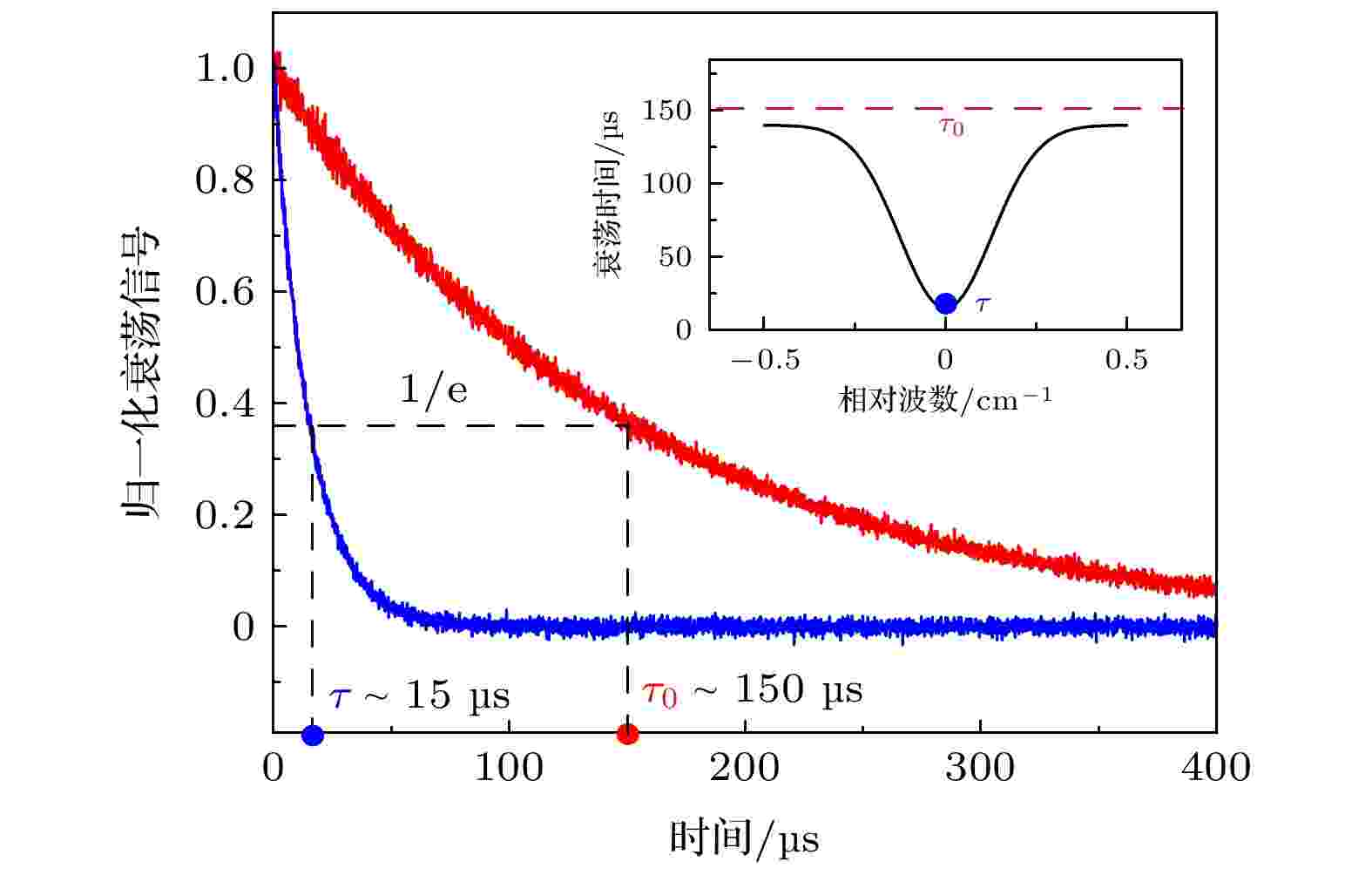
EDITOR'S SUGGESTION
2023, 72 (4): 043302.
doi:10.7498/aps.72.20221851
Abstract +
Since H2S is a corrosive and toxic gas pollutant, the accurate measurement of its concentration is significant. However, in the practical industrial processes, it is difficult to implement because of the disturbance caused by other emissions such as CO2and CO. Therefore, in this work, the concentration of H2S, CO2and CO are measured simultaneously based on cavity ring-down spectroscopy (CRDS) as a viable alternative to measure the concentration of H2S accurately when CO2and CO exist. First, the wavelength of mixed gas within a range of 6336–6339 cm–1is selected as the target region where the spectral line intensity of H2S is stronger than 10 times that of CO2or CO and the water absorption is extremely weak. Second, the influence of the sampling length (Tm) on the accuracy of the ring-down time is analyzed by evaluating average (accuracy), standard deviation (precision) and consumption time (speed). Third, the experiments are carried out at different pressures in order to obtain the optimal pressure condition. Fourth, the concentration of trace H2S is measured when the disturbances caused by CO2or CO are added, and the error of the measured concentration is analyzed. Finally, the detection limit of CRDS-based system is calculated to be 6.9 ppb by analyzing the SNR of four groups of low concentration H2S spectra, while the lower limit of detection of CRDS-based system is calculated to be 2 ppb by analyzing the Allan variance of long-term data. The measured concentration and its desired value show a good linearity at different dilution ratios. Both the high linearity and the low detection limit of H2S indicate the effectiveness of the CRDS-based measurement system to measure H2S when CO2and CO exist. The successful application of the CRDS-based system to the measurement of H2S shows its promising prospect in gas concentration measurement for practical industrial processes.

EDITOR'S SUGGESTION
2023, 72 (4): 043401.
doi:10.7498/aps.72.20221875
Abstract +
Energy loss of ions near the Bohr velocity in plasma is one of the important topics in intense heavy ion beam driven high energy density physics and inertial confinement fusion. Based on the ions-plasma interaction experimental platform at HIRFL, this work shows the new experimental energy loss results of 1.07 MeV (~66.9 keV/u) O5+ions penetrating through a low-density partially ionized hydrogen plasma target (radio frequency plasma). The decrease of energy loss with free electron density increasing is found, which is very different from our previous result. The new experimental results are discussed by considering the theoretical models which involves the charge screening of projectiles in the partially ionized plasma and the target polarization effect-Barkas correction term. For the charge screening , the comparison between the momentum transfer under the Coulomb potential and that under the Debye potential is given, but due to the low ionization degree, the plasma screening effect seems not to be the main reason for the decrease of energy loss. For the target polarization effect , in the Bohr velocity regime, the Barkas correction term can play a key role in the ion-atom collisions. Modeling the Barkas correction term based on the proposed classical energy loss formula, the experimental data of ions in the gas target can be well fitted by the calculated values. In the partially ionized plasma, the frequent thermal electron collisions can give rise to the atomic excitation of plasma target, correspondingly the Barkas correction term changes: it decreases with the fraction of excited atoms increasing. As a result, the energy loss decreases in our experiment. In the stopping of highly charged ions in a partially ionized low-density plasma, the collisions between ions and free electrons can produce an enhanced energy loss according to previous studies. However, the target polarization effect, especially the atomic excitations, can significantly reduce the energy loss, which is observed in our experiment. Therefore, the interaction between ions and partially ionized plasma should be further studied, and the Barkas correction can be a very important term.

2023, 72 (4): 043402.
doi:10.7498/aps.72.20221952
Abstract +
Silicon dioxide (SiO2) is an important component of nuclear reactor optical fiber and is also a candidate material for wast solidification. Owing to its special physical and chemical characteristics, it is used in many different technology fields like optics, electronics, energy orspace. Swift heavy ion irradiation can modify the crystal structure and optical property of optical material SiO2. Swift heavy ions deposit their energy mainly by inelastic interaction. Highly ionized lattice atoms may be formed along the trajectory, and a fraction of their electrical energy can be converted directly into the kinetic energy of the ions. The irradiation experiment is performed with Xeq+ions at the irradiation terminal of the sector-focused cyclotron at heavy-ion research facility in Lanzhou (HIRFL). The on-line spectral measurement experiment is carried out during irradiation. In the darkroom, the UV-visible light emission from the target is focused into optical fiber by a collimating lens, and then is analyzed with the Sp-2558 spectrometer equipped with a 1200 g/mm optical grating blazed at 500 nm. In the present work, SiO2single crystals are irradiated with 93–609 MeV Xeq+ions with a dose in a range of 1×1011–3×1011ions/cm2. During irradiation, the emission spectra, in a range of 200–800 nm, from SiO2irradiated by 93, 245, 425 and 609 MeV Xeq+ions, are obtained. Two emission bands centered at 461 and 631 nm are observed. These emission bands are produced by Frenkel exciton radiation de-excitation and their intensities are closely related to the irradiated ion energy and radiation dose. The results show that the light intensity increases with the electron energy loss index increasing. And owing to crystal damage caused by ion irradiation, the intensity of emission spectrum decreases with the augment of irradiation dose. Ion loses its energy throughout the ion track via Sn and Se interacting with target atoms and electrons respectively, and the energy lost by the ion is estimated by using SRIM code. The SRIM simulated ion ranges and recoil atom distribution, target ionization (energy loss to target electrons), damage production in SiO2are presented. Based on the energy deposition process, the emission bands related to the crystal structure itself are discussed. It indicates that electron energy loss plays a leading role in the process of light emission. In-situ measurement of the optical emission is of great significance in studying the irradiation modification and can help to understand the process of crystal damage caused by ion irradiation.
ELECTROMAGNETISM, OPTICS, ACOUSTICS, HEAT TRANSFER, CLASSICAL MECHANICS, AND FLUID DYNAMICS
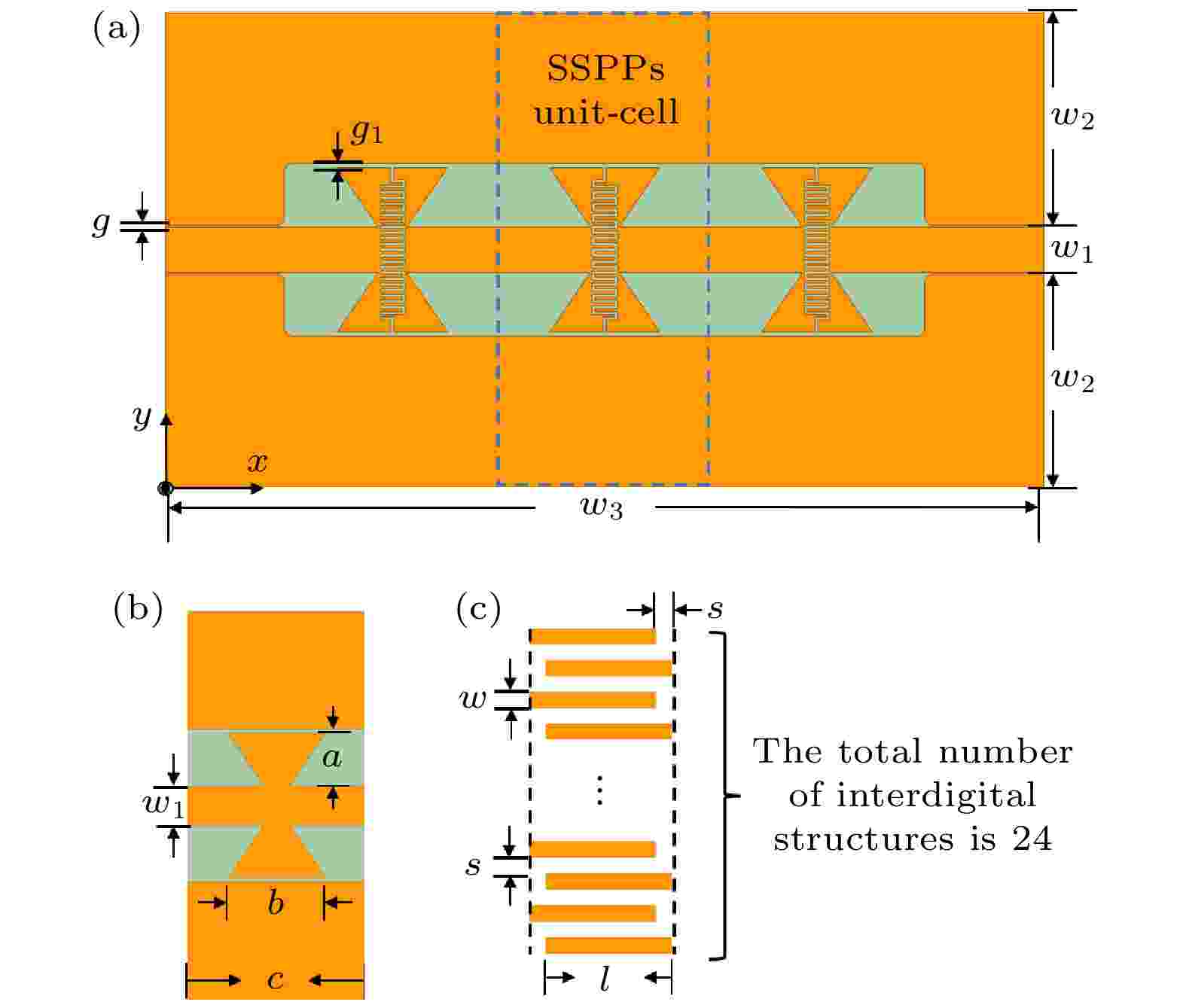
2023, 72 (4): 044101.
doi:10.7498/aps.72.20221984
Abstract +
In this paper, a dual passband filter with spoof surface plasmon polaritons (SSPPs) and interdigital capacitance structure loaded on a coplanar waveguide (CPW) is proposed. First, the hourglass-shaped SSPP unit-cell structure and the interdigital capacitor structure are introduced on the coplanar waveguide transmission line to obtain high fractional bandwidth and low insertion loss passband characteristics. Then, a dual passband filter is formed by loading the interdigital capacitor loop resonator to excite the trapped waves. The simulation results show that the proposed dual passband filter has excellent upper sideband rejection and dual passband filtering performance. The fractional bandwidths of the two passbands of the design are 46.8% (1.49–2.40 GHz) and 15.1% (2.98–3.63 GHz), respectively, which can achieve more than –40 dB rejection in a range of 4.77–7.48 GHz. The upper cutoff frequency and lower cutoff frequency of the two passbands can be independently regulated by changing the structural parameters of the proposed filter. In order to gain a more in-depth understanding of the operating principle of the dual passband filter, the corresponding dispersion curves and electric field distribution, LC equivalent circuit analysis are given. Finally, the prototype of the designed filter is fabricated according to the optimized parameter values. The experimental results are in good agreement with the simulation ones, indicating that the proposed dual-passband filter is of great importance in implementing microwave integrated circuits .
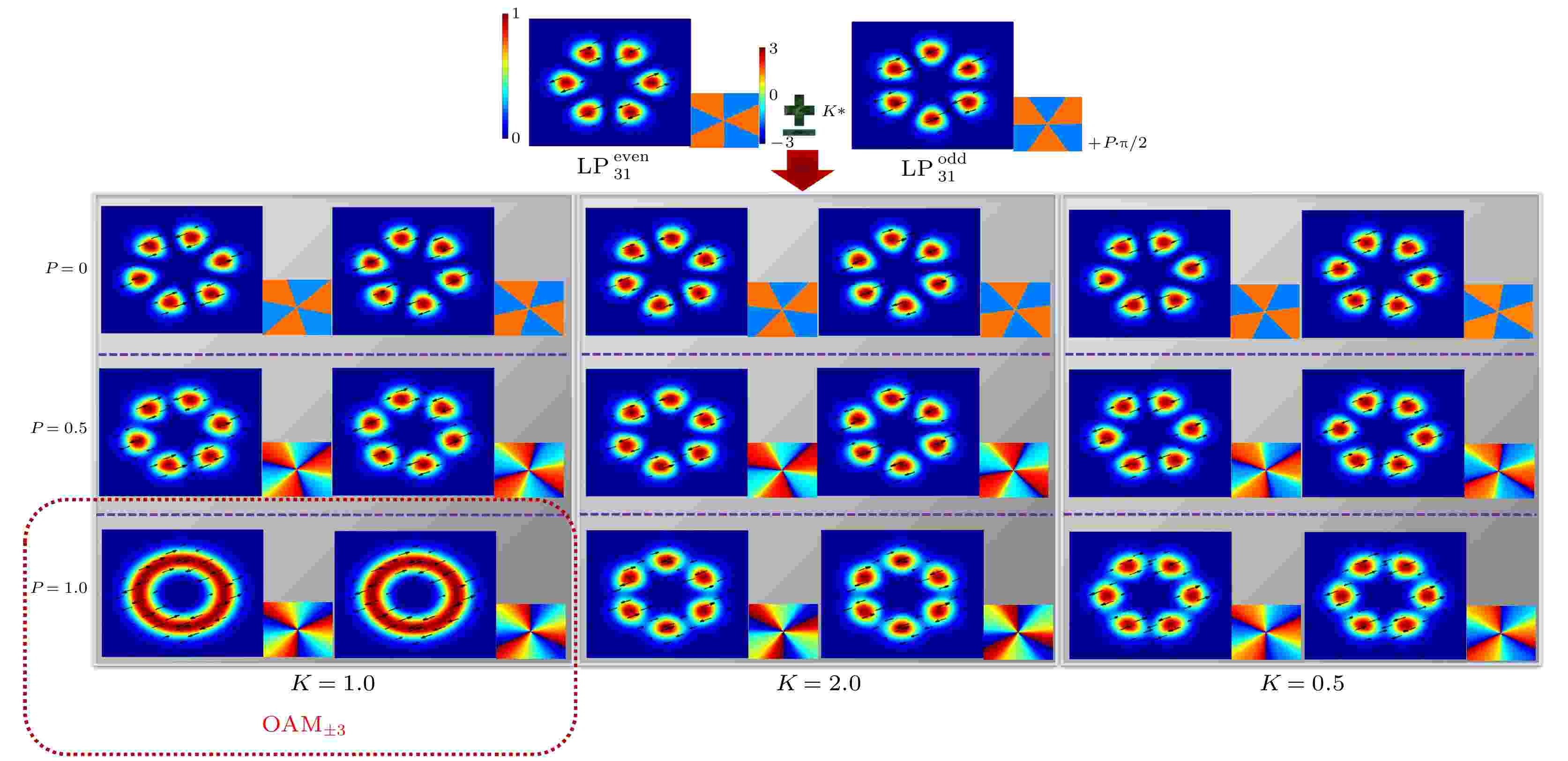
EDITOR'S SUGGESTION
2023, 72 (4): 044201.
doi:10.7498/aps.72.20221928
Abstract +
The generation of orbital angular momentum (OAM) modes is very important, for they have a variety of applications such as in optical tweezers, quantum optics, and optical communication systems. Particularly, how can high-order OAM modes be generated efficiently in fibers with the advantage of low cost and compatible with fiber system? The Traditional method for first order to third order OAM is based on long period fiber grating (LPFG) fabricated by carbon dioxide laser. However, high power and large focused spot of carbon dioxide laser are unfavorable for stable and repeatable generation of higher-order OAM, which needs the LPFG with small grating pitch. In order to solve this problem, a third-order OAM mode converter based on femtosecond microfabrication is proposed and fabricated for the first time. With the advantage of 4.4 μm focused spot size near the core, lower power and lower heat absorption efficiency, this method can be more stable and promising. Therefore, we first carry out the mode filed analysis and simulate the intensity and phase profiles of the superposed mode field in LP odd-even mode on different scales and phases patterns to obtain OAM mode. Second, we use the coupled-mode theory to analyze and simulate the transmission spectrum of LPFG, which guides the setting of the grating parameters such as the grating pitch, the depth of modulation and the length of the grating. By experimental verification, an asymmetric modulated long-period fiber grating with a pitch setting to 194 μm is fabricated on a six-mode fiber. The fundamental mode can be converted into the third-order angular linear polarization mode LP31mode with 98% mode conversion efficiency near 1550 nm, and further converted into the OAM±3modes by superposition of the odd and even LP31mode with ±π/2 phase difference. At the same time, this fiber grating can also generate LP12mode with 90% mode conversion efficiency near 1325 nm. Then we can take the same approach to transform LP12mode into OAM modes with angular first-order as well as radial second-order. The experimental result is consistent with the simulation result. Thus, this scheme provides an idea for generating the high-order OAM modes in all-fiber systems by using only one grating with high repeatability.
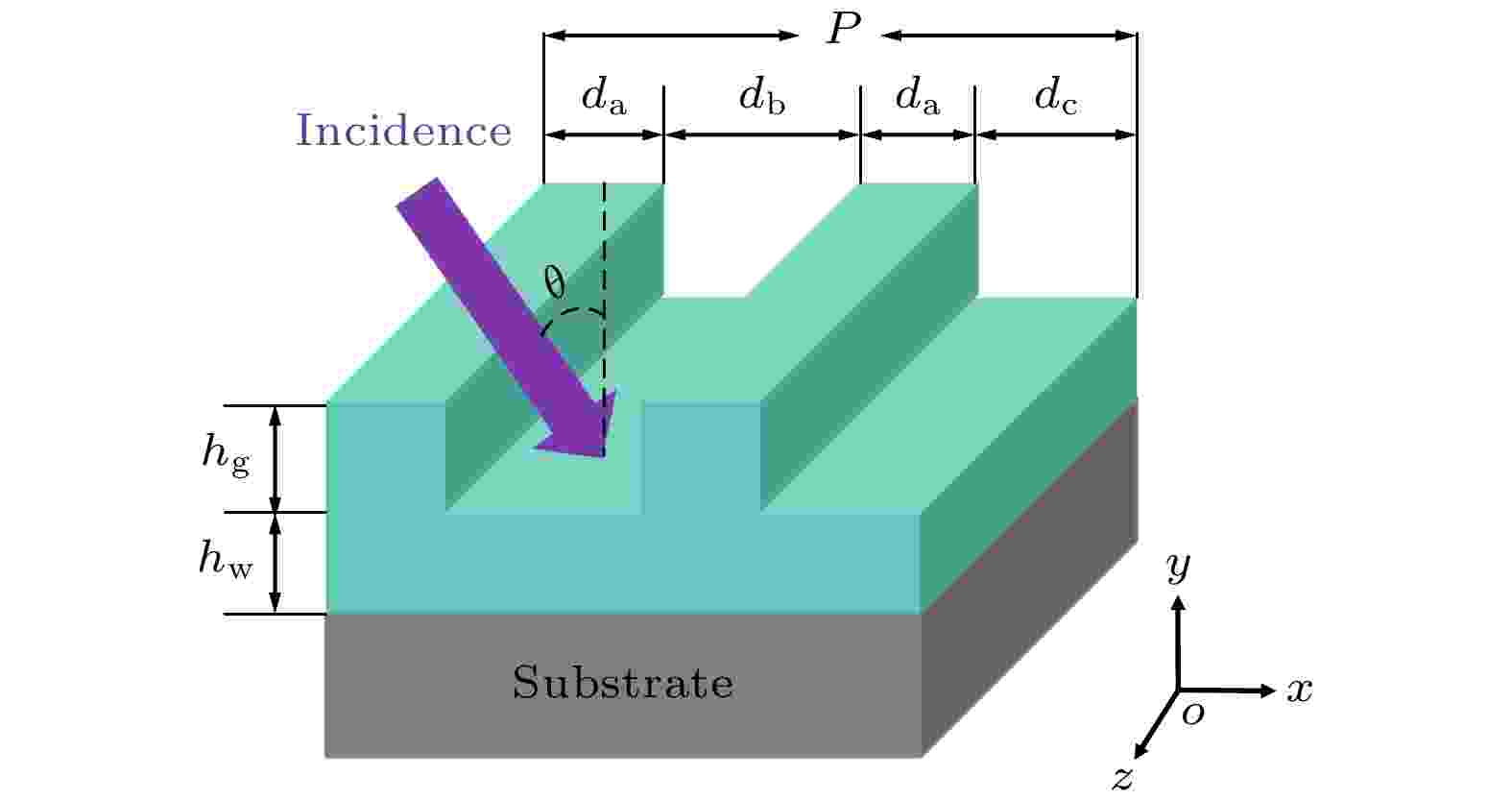
EDITOR'S SUGGESTION
2023, 72 (4): 044202.
doi:10.7498/aps.72.20221894
Abstract +
As a nanoscale coherent light source, semiconductor nanolaser is a key device for future optoelectronic integrated chips. The obstacle of further miniaturization of the nanolaser is that the loss increases rapidly with the decrease of cavity volume. The bound states in the continuum (BICs) can overcome the high radiative loss. Here, we propose a nanolaser based on quasi-BIC mode supported by all-dielectric resonant waveguide grating (RWG), which can effectively reduce the threshold of nanolaser. The quasi-BIC mode of the waveguide can be excited when the traditional two-part grating becomes a four-part grating. The laser behavior of the quasi-BIC is studied by finite difference-time-domain (FDTD) numerical simulation. The results show that the threshold of the naolaser based on four part-grating RWG is 20.86% lower than that of nanolaser based on two part-grating RWG when subjected to TE-polarized light irradiation. For the TM-polarized light irradiation, the threshold is 3.3 times lower than the threshold for the nanolaser based on four part-grating RWG. We also find that the threshold of the nanolaser under TE-polarized light irradiation is about one order of magnitude lower than that under TM-polarized light irradiation. Because the electric field of the structure is well confined inside the waveguide layer under TE-polarized light, which can enhance the interaction between light and gain materials and reduce the threshold of nanolasers.
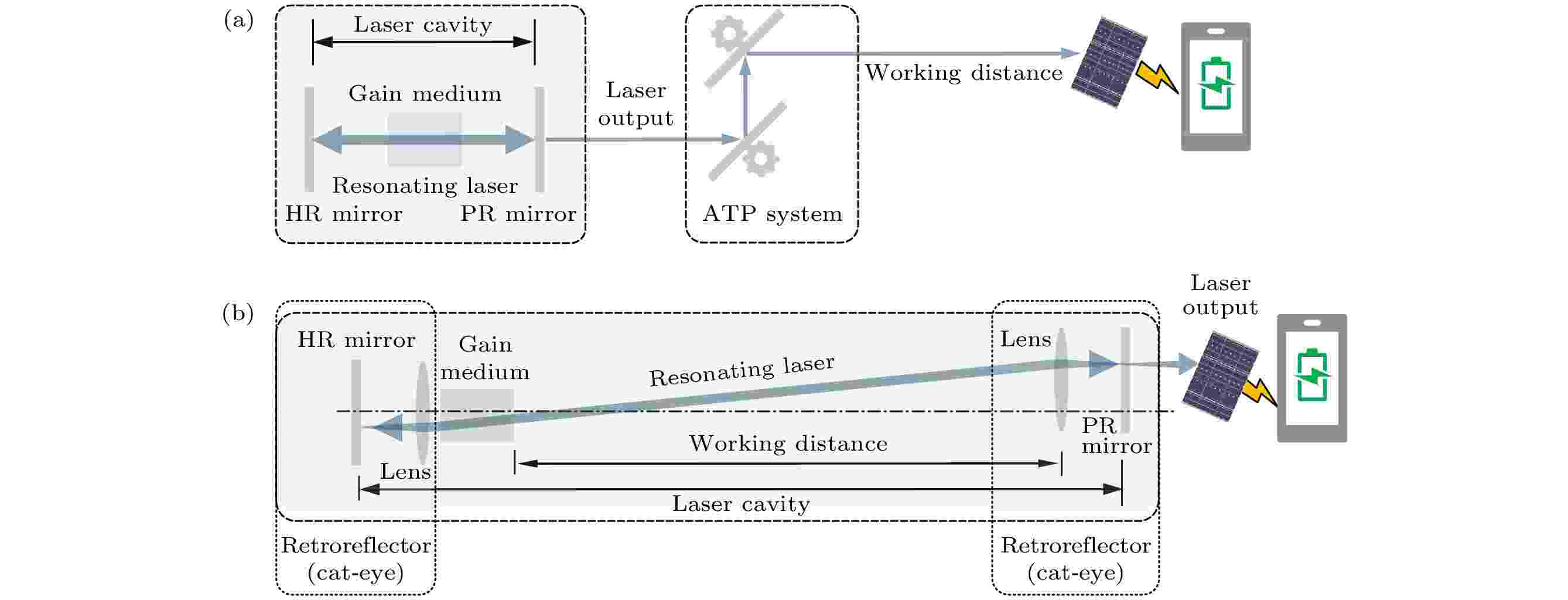
2023, 72 (4): 044203.
doi:10.7498/aps.72.20221956
Abstract +
Lasers with cavities consisting of retroreflecting elements can give the potential for large-dynamic-range alignment-free operation, which makes the important applications in adaptive wireless laser power transfer/communication possible. In such an emerging approach based on resonant laser beam in the cavity, the laser is delivered to the photovoltaic cell for charging application (or photodiode for communication application) at the receiver automatically, without the necessity of positioning and aiming the receiver in conventional laser wireless power transfer techniques. The laser capable of operating alignment-free efficiently across large-dynamic-range is essential for the application. In this work, the requirements for the dynamic range of alignment-free operation are summarized. An alignment-free laser with a cavity consisting of cat-eye retroreflectors is designed, and a large alignment-free dynamic range as never before is experimentally demonstrated. Telescope system in the laser cavity is adopted to suppress the beam expansion to enhance the working distance between the laser transmitter and the receiver. Coupled cavity scheme is used to reduce the laser intensity between the transmitter and the receiver for laser safety. By calculating the stability zone of the laser cavity, it is found that the stability zone of the receiver cat-eye distance is quite narrow. Hence, the laser operation is very sensitive to the defocusing of the cat eye defocusing. Moreover, the cat eye defocusing induced by optical aberrations of spherical aberration and field curvature can be rather serious, when the long working distance results in a large beam size and the angle of incidence is large, hence limiting the effective working distance and the field of view of the alignment-free laser significantly. In the experiment, the improved optical designs with the aberrations compensation are adopted for large-dynamic-range alignment-free operation. The end-pumped Nd:GdVO4laser at 1063 nm can deliver over 5-W output within a working distance range of 1–5 m, and a receiver field of view of ±30°, without cavity realignment. The transmitter field of view reaching 4.6° (full width at half maximum) at a working distance of 5 m is also realized, with a corresponding receiver transverse movement range of 40 cm. Our work clarifies the optimizing criteria of the large-dynamic-range alignment-free laser based on cat-eye retroreflectors.

2023, 72 (4): 044301.
doi:10.7498/aps.72.20221495
Abstract +
Convergence-zone (CZ) sound propagation is one of the most important hydro-acoustic phenomena in the deep ocean, which allows the acoustic signals with high intensity and low distortion to realize the long-range transmission. Accurate prediction and identification of CZ is of great significance in implementing remote detection or communication, but there is still no standard definition in the sense of mathematical physics for convergence zone. Especially for the issue of systematic error of computation introduced by the earth curvature, there is no exact propagation model. The curvature-correction methods always lead to the imprecision of the ray phase. In previous research work, we realized that the Riemannian geometric meaning of the caustics phenomena caused by ray convergence is that the caustic points are equivalent to the conjugate points, which form on geodesics with positive section curvature. In this work, we present a spherical layered acoustic ray propagation model for CZ based on the Riemannian geometric theory. With direct computation in the curved manifolds of the earth , a Riemannian geometric description of CZ is provided for the first time, on the basis of comprehensive analysis about its characteristics. And it shows that the mathematical expression of section curvature adds an additional item
${{\hat c(l){{\hat c}^\prime }(l)}}/{l}$
after considering the earth curvature, which reflects the influence of the earth curvature on the ray topology and CZ. By means of Jacobi field theory of Riemannian geometry, computational rule and method of the location and distance of CZ in deep water are proposed. Taking the typical Munk sound velocity profile for example, the new Riemannian geometric model of CZ is compared with the normal mode and curvature-correction method. Simulation and analysis show that the Riemannian geometric model of CZ given in this paper is a mathematical form naturally considering the earth curvature with theoretical accuracy, which lays more solid scientific foundations for the study of convergence zone. Moreover, we find that the location of CZ moves towards sound source when the earth curvature is considered, and the width of CZ near the sea surface first increases and then decreases with sound propagation proceeding. The maximum width is about 20 km and the minimum is about 4 km.
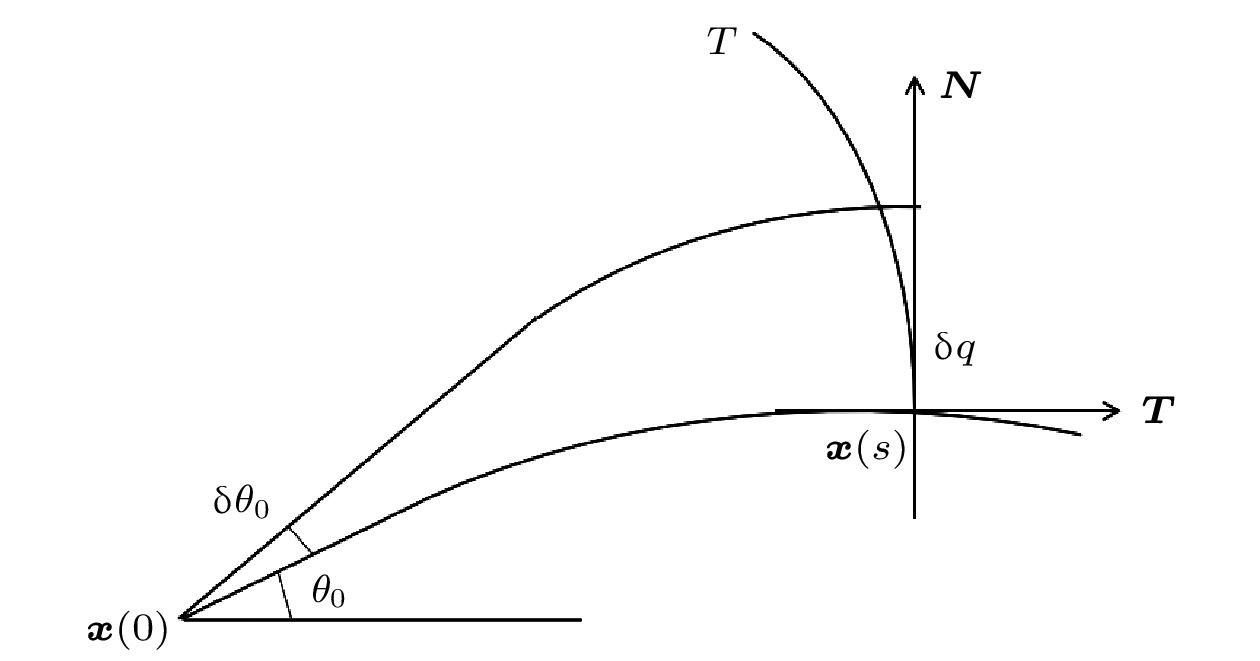
2023, 72 (4): 044302.
doi:10.7498/aps.72.20221451
Abstract +
Underwater sound propagation models are generally established from the extrinsic perspective, that is, embedding acoustic channels in Euclidean space with a fixed coordinate system. Riemannian geometry is intrinsic for curved space, which can describe the essential properties of background manifolds. The underwater acoustic Gaussian beam is originally adopted from seismology. Till now it has been the most important method used in acoustic ray based modeling and applications. Owing to the advantages of Gaussian beam method over the traditional ray counterpart, it is the mainstream technology of ray propagation computational software such as the famous Bellhop. With the assumption of Euclidean space, it is hard to grasp the naturally curved characteristics of the Gaussian beam. In this work, we propose the Riemannian geometry theory of underwater acoustic ray propagation, and obtain the following results. 1) The Riemannian geometric intrinsic forms of the eikonal equation, paraxial ray equation and the Gaussian beam under radially symmetric acoustic propagation environments are established, which provide a Riemannian geometric interpretation of the Gaussian beam. In fact, the underwater acoustic eikonal equation is equivalent to the geodesic equation in Riemannian manifolds, and the intrinsic geometric spreading of the Gaussian beam corresponds to the lateral deviation of geodesic curve along the Jacobian field. 2) Some geometric and topological properties of acoustic ray about conjugate points and section curvature are acquired by the Jacobi field theory, indicating that the convergence of ray beam corresponds to the intersection of geodesics at the conjugate point with positive section curvature. 3) The specific modeling method under horizontal stratified and distance-related environment is presented by using the above theory. And we point out that the method proposed here is also applicable to other radially symmetric acoustic propagation environments. 4) Simulations and comparative analyses of three typical underwater acoustic propagation examples, confirm the feasibility of the Riemannian geometric model for underwater acoustic propagation, and show that the Riemannian geometric model has exact mathematical physics meaning over the Euclidean space method adopted by the Bellhop model. The basic theory given in this paper can be extended to the curved surface, three-dimensional and other complex propagation cases. And especially it lays a theoretical foundation for the further research of long-range acoustic propagation considering curvature of the earth.
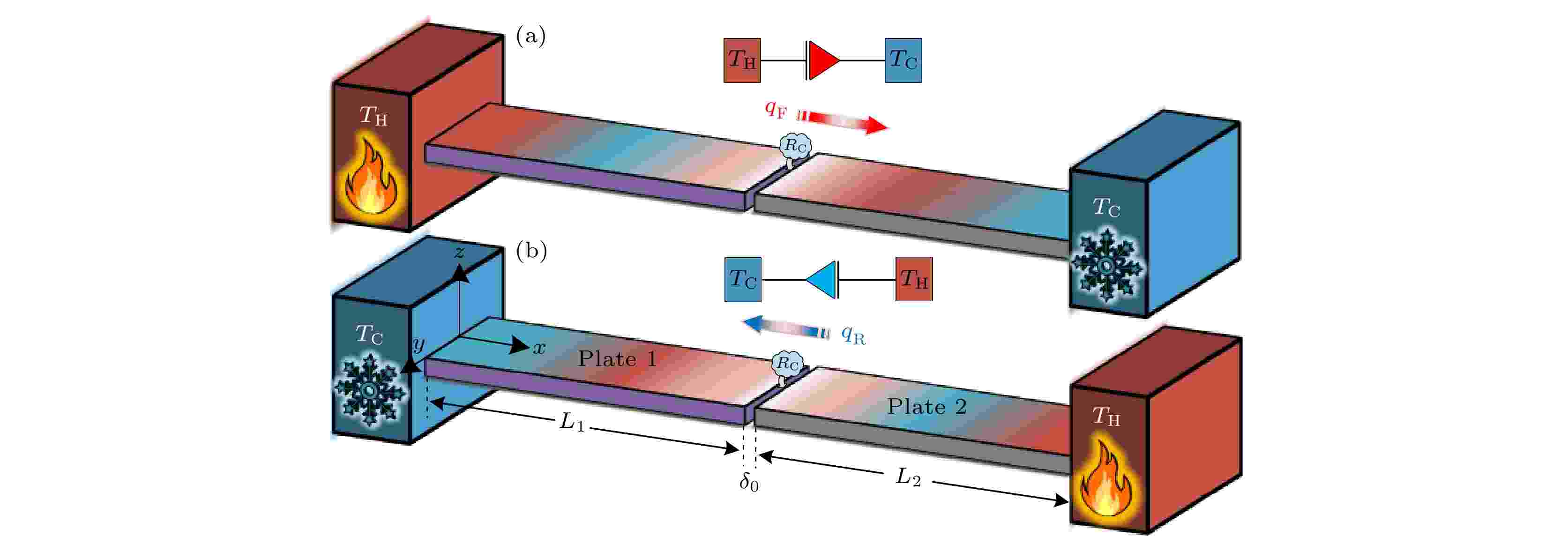
2023, 72 (4): 044401.
doi:10.7498/aps.72.20222085
Abstract +
Like an electric diode, thermal diode transmits heat in a specific direction, and thermal rectification is also a fundamental phenomenon for active heat flow control. However, in practical applications, thermal rectification needs to be operated under transient conditions. In this study, transient thermal rectification ratio of a one-dimensional heterostructure is numerically investigated by using the finite element method. The effects of interface thermal resistance, interface initial gap, periodic boundary condition and geometric and material parameters on the transient thermal resistance ratio are obtained. Research indicates that the interface thermal resistance can enhance the thermal rectification effect of the system, and the introduction of the initial interface gap improves the transient thermal rectification ratio by an order of magnitude. The ability to engineer the thermal diffusivity of materials allows us to control the heat flux and improve transient thermal rectification ratio. Since interface thermal resistance can enlarge the difference in heat transfer capability between forward case and reverse case, it is reasonable to suggest that adjusting the interface thermal resistance may also enhance the thermal rectification effect, but excessive interface thermal resistance will reduce it. Under the periodic temperature boundary conditions, the larger the temperature difference in boundary fluctuation, the larger the fluctuation amplitude of the transient thermal rectification ratio is. The fluctuation frequency of thermal rectification changes with the periodic boundary frequency, which also affects the amplitude of the fluctuation. Furthermore, by adjusting the initial interface gap, the gap is closed during heat transfer and the interface thermal resistance is reduced in the forward case, while the interface gap is kept open in the reverse case, thereby improving the overall thermal rectification ratio by an order of magnitude. For different transient stages, the equivalent thermal conductivity can be changed by adjusting the material and geometrical properties to improve the thermal rectification ratio.Therefore, the proposed numerical approach and results can guide the optimal design of the transient thermal rectifier.

2023, 72 (4): 044701.
doi:10.7498/aps.72.20221967
Abstract +
Based on the multi-component phase field theory, in this paper we propose an axisymmetric lattice Boltzmann model for three-phase fluids. The proposed model takes advantage of two particle distribution functions for capturing phase interface among three different fluids, and another particle distribution function for solving the hydrodynamic equations for flow field. In order to describe the axisymmetric effect arising from the coordinate transformation, we elaborately design the equilibrium distribution function and forcing distribution function in the evolution equation, which ensures that the model can accurately recover the macroscopic governing equation for three-phase fluids. Also, the introduced source terms accounting for the axisymmetric effect contain no additional gradient term, which makes it be simpler than the existing lattice Boltzmann model for axisymmetric three-phase fluids. To validate the proposed model, a series of axisymmetric multiphase benchmark examples are performed, including the static double droplets, the spreading of liquid lens, and the binary-fluid Rayleigh-Plateau instability. It is reported that the present model can accurately capture the phase interface, and the predicted steady shapes of the liquid lens agree well with the analytical profiles. Then, the proposed model is used to study the three-phase Rayleigh-Plateau instability and the effects of the wavenumber and the radius ratio of liquid column on the interfacial dynamic behaviour, the breakup time of liquid threads and the size of daughter droplet are investigated in detail. It can be found that the compound liquid thread at a high wavenumber could break up into one main droplet and one satellite droplet, but the multiple satellite droplets can be produced at a low wavenumber, which leads to that the sizes of main and satellite droplets increase with the wavenumber at first and then decrease with it. Besides, we can observe that the inner fluid undergoes the breakup at earlier time than the middle fluid, and the breakup time for both inner and middle fluids increases with the decrease of the wavenumber. Finally, we can find that increasing the radius ratio of liquid column accelerates the breakup of inner-fluid thread, but prevents the breakup of the middle-fluid thread. In addition, the size of the compound main droplet increases with the radius ratio of liquid column, while the size of the compound satellite droplet doest not change much with it.

2023, 72 (4): 044702.
doi:10.7498/aps.72.20221879
Abstract +
This article focuses on the effect of active control via synthetic jets (SJs) on sound generated by a two-dimensional circular cylinder by using the acoustic analogy method. The cylinder is immersed in a uniform upstream flow, where the corresponding Reynolds number is 100 and the Mach number is 0.1. A pair of SJs is placed near the cylinder’s separation point issuing periodically varying forcing, with different combinations of forcing frequency and phase difference. The lattice Boltzmann method (LBM) is coupled with the multi-direct forcing immersed boundary method to solve the near-field flow dynamics. The mechanism of the sound generation lies in the fact that pressure pluses are induced by the periodic vortex shedding from the cylinder’s surface, i.e. dipoles. In the case with active flow control, extra monopoles are generated by the unsteady flow rate resulting from the SJs' periodic blow/suction. The interaction between monopoles and dipoles is confirmed to have a big influence on the acoustic field. The acoustic analogy method is used in various cases with a wide range of control parameters, because it has a considerably lower computational cost than the direct simulation method. Taking into account the effect of the monopole, the acoustic analogy method is developed for solving two-dimensional sound field by substituting the Green’s function. Results indicate that the primary lock-on and the secondary lock-on occur in the case of specified control parameters. The frequency of vortex shedding is related to the SJs’ frequency, deviating from the unforced frequency. Owing to the noise induced by flow, the frequency and phase difference of the SJs also have significant influence on sound field. The far-field noise is enlarged although the SJs reduce drag, due to the induced extra monopole, as well as the strengthened hydrodynamic fluctuation. Further increasing SJs’ frequency or reducing the phase difference will enlarge the far-field noise and make the directivity transformed from dipole to monopole, since the SJs’ self-noise is stronger. Moreover, it is found that the acoustic power increases approximately 4–18 dB compared with the unforced circular cylinder and the drag dipole is strengthened in all combinations of control parameters. This study deepens the understanding of the effect of SJs on sound field, and provides a reference for future studying the control strategies of suppressing noise generated from bluff bodies.
PHYSICS OF GASES, PLASMAS, AND ELECTRIC DISCHARGES

2023, 72 (4): 045201.
doi:10.7498/aps.72.20221305
Abstract +
Surface plasma wave (SPW) will significantly affect the subsequent mutual coupling between laser and plasma, so there are many important applications such as particle acceleration driven by laser pulses and transmission enhancement. In this work, the properties of the SPW produced by an ultra-short and ultra-intensity laser pulse incident on a double-layer plasma target are studied by using the all-electromagnetic large-scale two-dimensional particle in cell (PIC) simulations. It is shown that the high-intensity laser incident with a large angle,θ=75°, can drive the electrons of the low-density layer to form a transportable periodic structure with the propagation speed close to light speed, and excite electrostatic wave whose wavelength is similar to that of the incident laser and is numerically close to the theoretical result according to previous theory. In order to excite the SPW, the laser intensity needs to reach a certain threshold. Besides, the ratio of the surface wave intensity to the incident laser intensity in the double-layer target case obviously deviates from the theoretical result of the single-layer target case, showing a nonlinear relationship. In the second part of the simulation, it is found that the SPW can significantly enhance the transmission of subsequent laser pulse, allowing the subsequent laser to break through the "black barrier" due to the dense plasma. A pre-laser irradiates the double-layer plasma target atθ= 75°, and then the subsequent laser is normally incident after a delay of Δt= 23T. As a result, an obvious electromagnetic wave with the same direction as the sub-laser can be observed behind the target, which indicates that the sub-laser absolutely transmits the dense plasma. In comparison, when a single laser is normally incident on the target without pre-laser while other conditions keep unchanged, no obvious wave can be distinguished behind the target, that is, the field is nearly zero. Another simulation where a single-layer target is injected by pre-laser and sub-laser in order but the wave behind the target is also unobservable, proves that it is SPW that plays the main role in transmission enhancement instead of accelerated hot electrons on the target which can also transport the laser energy.
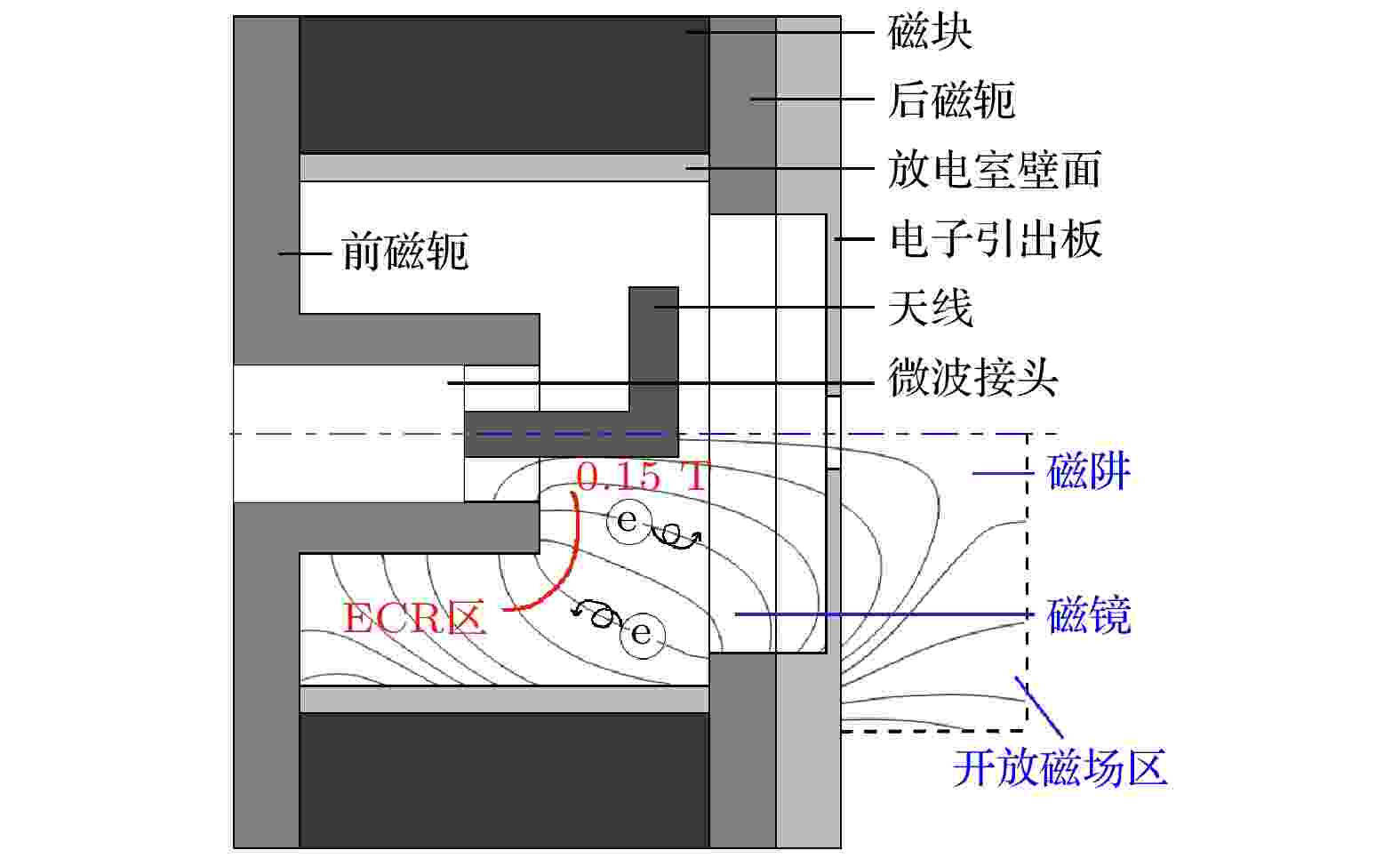
2023, 72 (4): 045202.
doi:10.7498/aps.72.20221951
Abstract +
Electron cyclotron resonance ion thruster (ECRIT) with a diameter of 10 cm can be operated in multiple types of gases and it is feasible to be applied to air-breathing electric propulsion systems. The study on the neutralizer of the ECRIT running in nitrogen gas is the basis for the study on the ECRIT running in nitrogen-oxygen mixed gas. When the ECR neutralizer of typical 10-cm ECRIT running in xenon gas runs in nitrogen gas, the extracted electron current is reduced, because ions tend to drift out of the neutralizer, due to the lower molecular weight of nitrogen. The typical neutralizer is no longer suitable for running in nitrogen gas. In this work, based on the 10-cm typical ECR neutralizer, in order to inhibit ions drifting out of the neutralizer and improve the performance of electron extraction, a bipolar ECR neutralizer suitable for running in nitrogen gas is experimentally studied. The results show that under the conditions of gas mass flow rate of 0.04 mg/s and input power of 10 W, the anode voltage required by the typical ECR neutralizer running in nitrogen gas is 150 V when the extracted electron current is 134 mA. However, the bipolar ECR neutralizer requires only 50-V anode voltage, which decreases by about 67%. When the anode voltage is 40V, the power loss of the typical ECR neutralizer is 1204.82 W/A, while the power loss of the bipolar ECR neutralizer is 95.23 W/A, which is about 8.3% of the former. The ion shielding effect of the bipolar ECR neutralizer running on nitrogen gas is remarkable and the electron extraction performance is improved.

2023, 72 (4): 045203.
doi:10.7498/aps.72.20222138
Abstract +

EDITOR'S SUGGESTION
2023, 72 (4): 045204.
doi:10.7498/aps.72.20222059
Abstract +
Microwave electric fields are measured by using cold Rydberg atoms. We obtain spindle-shaped cold atomic clouds in a magneto-optical trap and then pump the cold atoms to quantum state 5S1/2,F= 2,mF= 2 by using an optical-pump laser. We obtain the Rydberg electromagnetic induction transparency (EIT) spectrum peak with narrow linewidth by the low temperature and small residual Doppler broadening. The results show that the typical EIT linewidth with 16 μK cold atoms is about 460 kHz which is 15 times narrower than that of 7 MHz obtained in the thermal vapor cell. The microwave electric field amplitude is measured by Autler-Townes splitting (EIT-AT splitting) in the cold atoms at frequencies of 9.2, 14.2 and 22.1 GHz, receptively. The results show that there is a good linear relationship between the EIT-AT splitting interval and the microwave electric field amplitude. The lower limit of the microwave electric field amplitude that can be measured in the linear region can reach as low as 222 μV/cm, which is about 22 times larger than the lower limit in the traditional thermal vapor cell about of 5 mV/cm. The improvement of the lower limit by EIT-AT splitting method is roughly proportional to the narrowing EIT line width by cold atom samples. This demonstrates that benefiting from the smaller residual Doppler effect and the narrower EIT linewidth in cold atoms, the cold atom system is more advantageous in the experimental measuring of the weak microwave electric field amplitude by using the EIT-AT splitting method. This is of great benefit to the absolute calibration of very weak microwave electric fields. Furthermore, the lower limit of the microwave electric field amplitude that can be measured is smaller than 1 μV/cm by using the change of transmittance of the prober laser at the EIT resonance, and the corresponding sensitivity can reach 1 μV·cm–1·Hz–1/2. These results demonstrate the advantages of cold atomic sample in microwave electric field measurement and its absolute calibration.
CONDENSED MATTER: STRUCTURAL, MECHANICAL, AND THERMAL PROPERTIES

EDITOR'S SUGGESTION
2023, 72 (4): 046101.
doi:10.7498/aps.72.20221776
Abstract +
High-temperature superconducting films can be used for fabricating the cutting-edge high-temperature superconducting microwave devices because of their low microwave surface resistances. However, the microwave surface resistances of high-temperature superconducting materials are particularly sensitive to microstructure due to their special two-dimensional superconducting mechanisms and extremely short superconducting coherence lengths. To investigate the correlations between microstructure and microwave surface resistance of high-temperature superconducting materials, YBa2Cu3O7-δ(YBCO) films with different thickness are grown on (00l)-oriented MgO single-crystal substrates by using the pulsed laser deposition (PLD) technique. Electrical measurements reveal that their superconducting transition temperatures and room temperature resistances do not show significant difference. However, their microwave surface resistances in superconducting state display a significant difference. The characterizations of the microstructures of YBCO films by synchrotron radiation three-dimensional reciprocal space mapping(3D-RSM) technique show that the number of the grains with CuO2face parallel to the surface (c crystals), and the consistency of grain orientation are the main causes for the difference in microwave surface resistance.
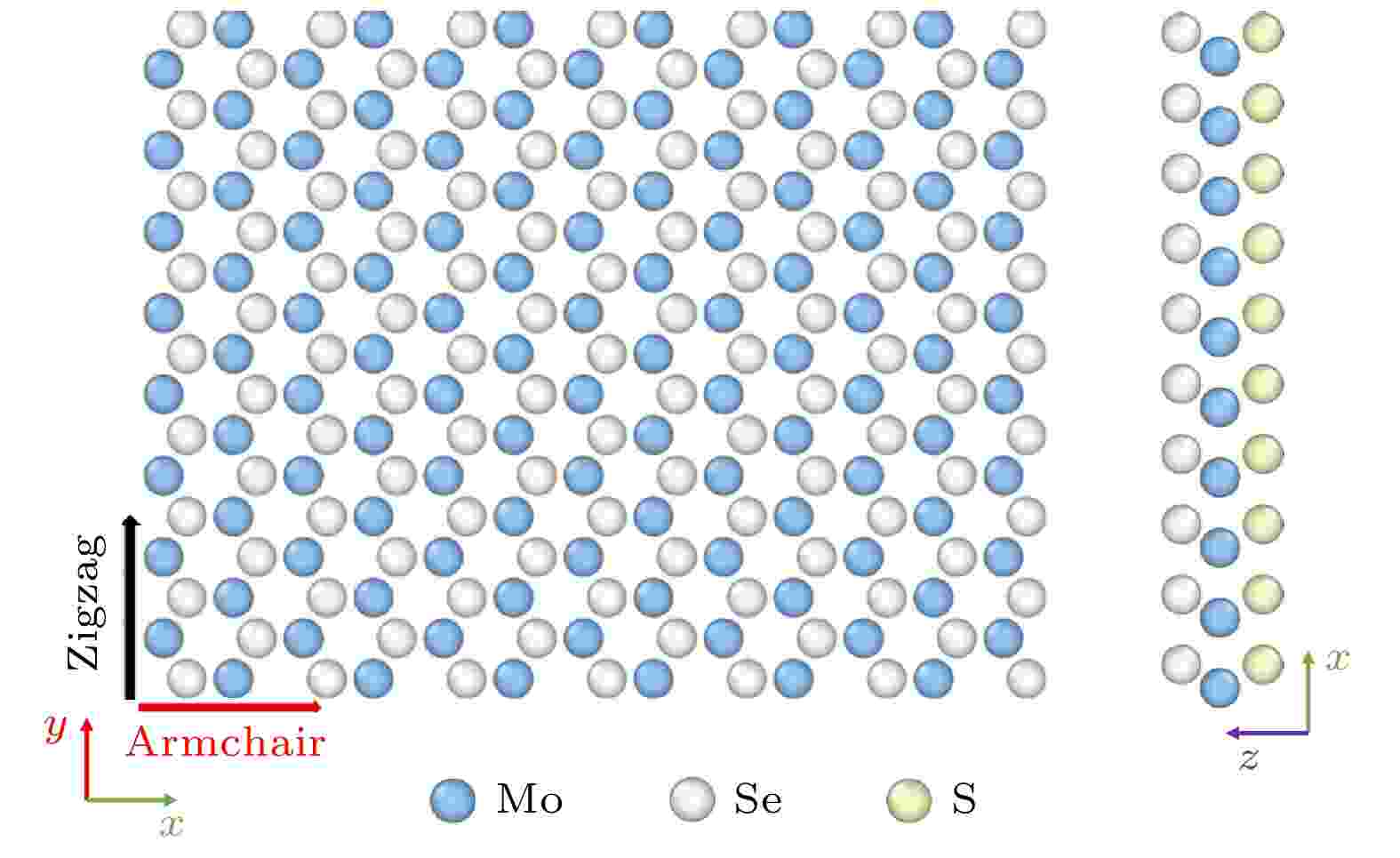
2023, 72 (4): 046201.
doi:10.7498/aps.72.20221815
Abstract +
This work systematically studies the mechanical responses of a novel semiconducting Janus MoSSe monolayer subjected to uniaxial tensile loadings by molecular dynamics simulations. It is found that the Janus MoSSe monolayer shows clearly anisotropic responses along armchair direction and the zigzag direction. The phase transition behavior is observed when the Janus MoSSe monolayer is under the action of tension along the zigzag direction at temperatures below 100 K, while it does not exist in any other conditions. The Young’s modulus, ultimate strength and ultimate strain decrease with temperature increasing. Particularly, the ductile-to-brittle fracture behavior is observed when uniaxial tension is applied along the zigzag direction depending on temperatures. The underline fracture mechanism is analyzed. Moreover, mechanical properties of Janus MoSSe monolayer with various grain boundaries are also carefully explored. It is found that the ultimate strength and ultimate strain depend more sensitively on narrow grains than on those wider ones. The crack is initialized near the grain boundaries and propagates along the direction almost perpendicular to the grain boundaries. The findings of this work may shed light on design and optimization of nanoscale electronic devices based on the Janus MoSSe monolayers.

2023, 72 (4): 046301.
doi:10.7498/aps.72.20222037
Abstract +

2023, 72 (4): 046401.
doi:10.7498/aps.72.20221567
Abstract +
MoSSe material is a very promising photoelectric material, and its application environment is aqueous solution. However, there is no research of the electrochemical stability of MoSSe materials in aqueous solution. In this work, the Pourbaix diagrams of monolayer MoSSe with different atomic ratios of molybdenum, sulfur and selenium are constructed based on density functional theory, and the thermodynamic stabilities and electrochemical corrosion behaviors under different pH values and electrode potentials are studied. The study of the pourbaix diagram of MoSSe shows that part of the corrosion-free region of MoSSe exists within the stable region of water in the Pourbaix diagram, indicating that the MoSSe can exist stably in the water environment. Compared with alkaline solutions, MoSSe has good corrosion resistance in acidic solution and neutral solution. The Pourbaix diagram of Mo4S2Se6, Mo4S6Se2, Mo4S7Se and Mo4SSe7show that in the case of high molar fraction of sulfur in monolayer MoSSe with different atomic ratios of molybdenum, sulfur and selenium, the conditions for the stable existence of materials in aqueous solution can have a larger range, and the corrosion resistance becomes better. In the case of high molar fractions of selenium in monolayer MoSSe with different atomic ratios of molybdenum, sulfur and selenium, the range of conditions for the stable existence of materials in aqueous solution becomes smaller, and the corrosion resistance becomes worse. In this work, the stabilities and corrosion behaviors of monolayer MoSSe with different atomic ratios of molybdenum, sulfur and selenium in aqueous solution are predicted, and the degradation behaviors of MoSSe materials are further explored, which can provide theoretical guidance for the application of MoSSe materials in the field of optoelectronics.
CONDENSED MATTER: ELECTRONIC STRUCTURE, ELECTRICAL, MAGNETIC, AND OPTICAL PROPERTIES
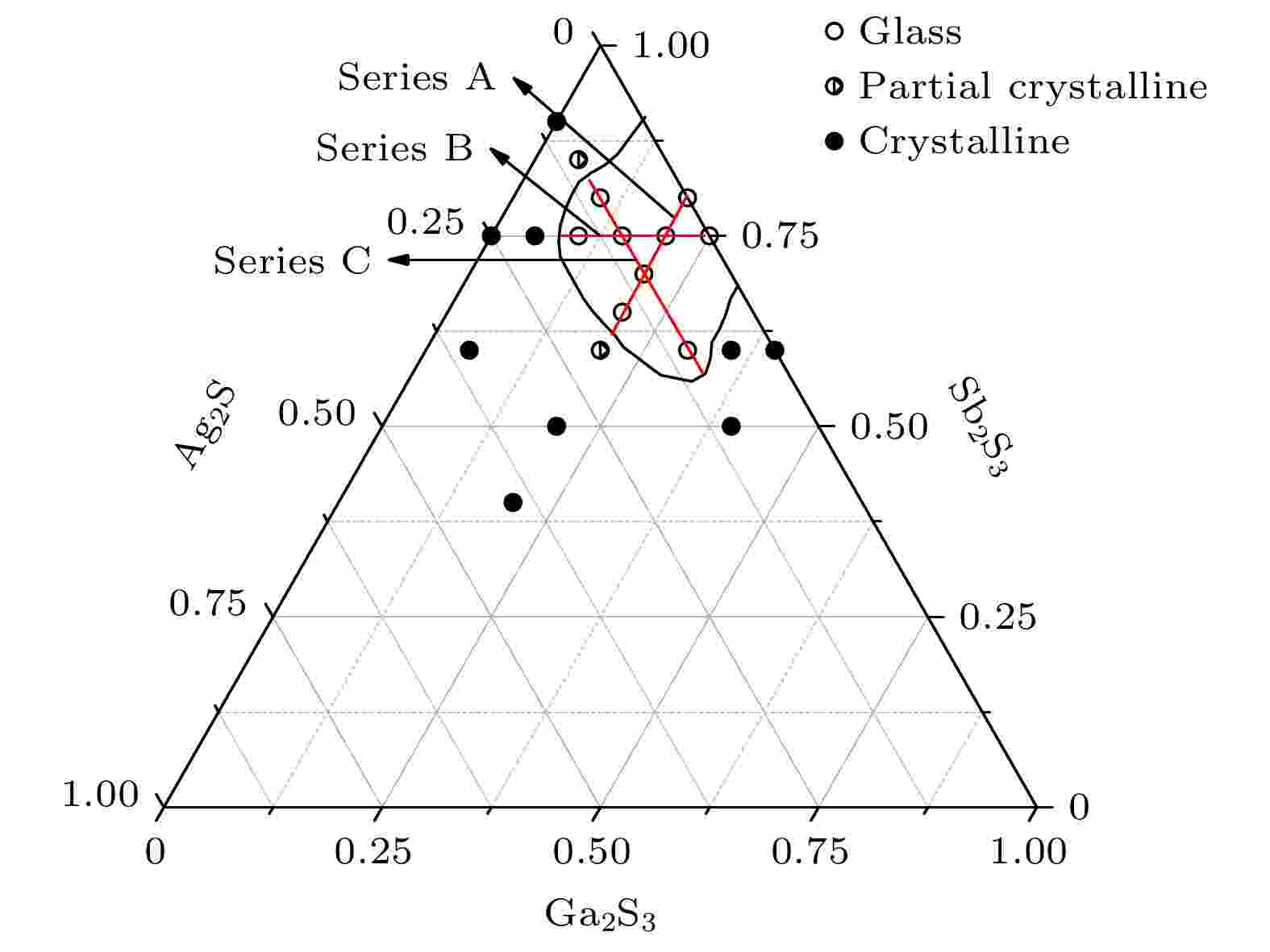
2023, 72 (4): 047101.
doi:10.7498/aps.72.20221380
Abstract +
With the rapid development of infrared technology and the wide applications of infrared optical components, the demand for infrared optical materials has risen significantly. Chalcogenide glass has been considered as one of the most popular infrared optical materials because of its wide infrared transmission range, high refractive index, low phonon energy, good rheological properties, low cost, etc. In this work, a new type of Ga2S3-Sb2S3-Ag2S chalcogenide glass system is reported, and its glass forming domain is determined. The thermal stability and optical property, mid-infrared (MIR) emission of rare earth dopant, and fiber-forming property for the glasses are studied. The potential applications of the glasses in the MIR region are also evaluated. The experimental results show that the Ga2S3-Sb2S3-Ag2S system has a glass forming domain of ~10%–30% Ga2S3, ~60%–80% Sb2S3and ~0–15% Ag2S (all in molar percentage). These glasses have a wide infrared transmission range of ~0.8–13.5 μm, relatively high linear refractive indices of~2.564–2.713 (at 10 μm), and relatviely large third-order nonlinear refractive indices of ~9.7×10–14–15.7×10–14cm2/W (at 1.55 μm). These excellent properties make the Ga2S3-Sb2S3-Ag2S glass promising material in the fields of infrared thermal imaging and nonlinear optics. Under the excitation of 1.32 µm laser, the rare earth dopant Dy3+shows strong 2.91 μm and 4.41 μm MIR emissions in the glass. According to the J-O theory, the three strength parameters (Ω2, Ω4, Ω6) of Dy3+in 0.05% weight of Dy3+doped 20Ga2S3-75Sb2S3-5Ag2S glass are 7.38×10–20cm2, 2.24×10–20cm2and 0.75×10–20cm2, respectively. The quantum efficiencies of the 2.91 μm and 4.41 μm emissions are calculated to be 76.6% and 70.8%, respectively, while the stimulated emission cross sections of those two bands are 1.27×10–20cm2and 1.43×10–20cm2, respectively. The fiber based on 20Ga2S3-75Sb2S3-5Ag2S: 0.05% Dy3+core glass and 20Ga2S3-70Sb2S3-10Ag2S cladding glass is fabricated by rod tube method. The fiber has good transmission performance in the 2–8 μm wavelength range, and the minimum loss is ~3.5 dB/m at 5.7 μm. The Dy3+ions show intense 2.93 μm and 4.45 μm MIR emissions in the fibers under 1.32 μm excitation. These results indicate that the Dy3+doped Ga2S3-Sb2S3-Ag2S glass fiber can be a promising candidate for MIR fiber laser medium.
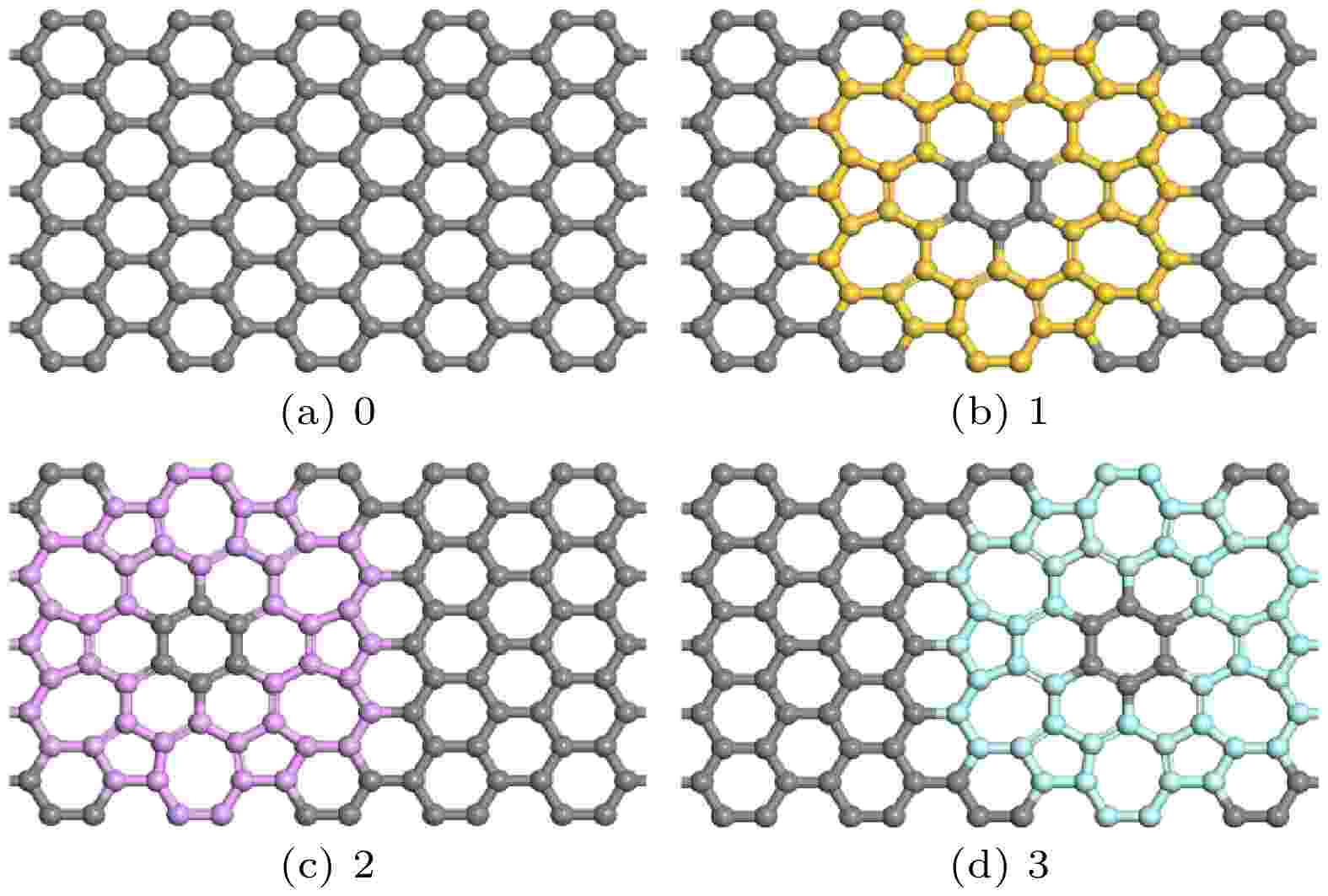
EDITOR'S SUGGESTION
2023, 72 (4): 047201.
doi:10.7498/aps.72.20222135
Abstract +
Owing to the huge degree of freedom of structure, the optimal design of thermoelectric conversion performance of defective graphene nanoribbons is one of the difficulties in the field of materials research. In this paper, the thermoelectric properties of graphene nanoribbons with 5-7 ring defects are optimized by using non-equilibrium Green's function combined with Bayesian algorithm.The results show that the Bayesian algorithm is effective and advantageous in the search of graphene nanoribbons with 5-7 ring defects with high thermoelectric conversion efficiency. It is found that the single configuration with the best thermoelectric conversion performance can be quickly and accurately searched from 32896 candidate structures by using Bayesian algorithm. Even in the least efficient round of optimization, only 1495 candidate structures (about 4.54% of all candidate structures) need to be calculated to find the best configuration. It is also found that the thermoelectric valueZT(about 1.13) of the optimal configuration of 5-7 ring defective graphene nanoribbons (21.162 and 1.23 nm in length and width, respectively) at room temperature is nearly one order of magnitude higher than that of the perfect graphene nanoribbons (about 0.14). This is mainly due to the fact that the 5-7 ring defects effectively inhibit the electron thermal conductivity of the system, which makes the maximum balance between the weakening effect of the power factor and the inhibiting effect of the thermal conductivity (positive effect). The results of this study provide a new feasible scheme for designing and fabricating the graphene nanoribbon thermoelectric devices with excellent thermoelectric conversion efficiencies.
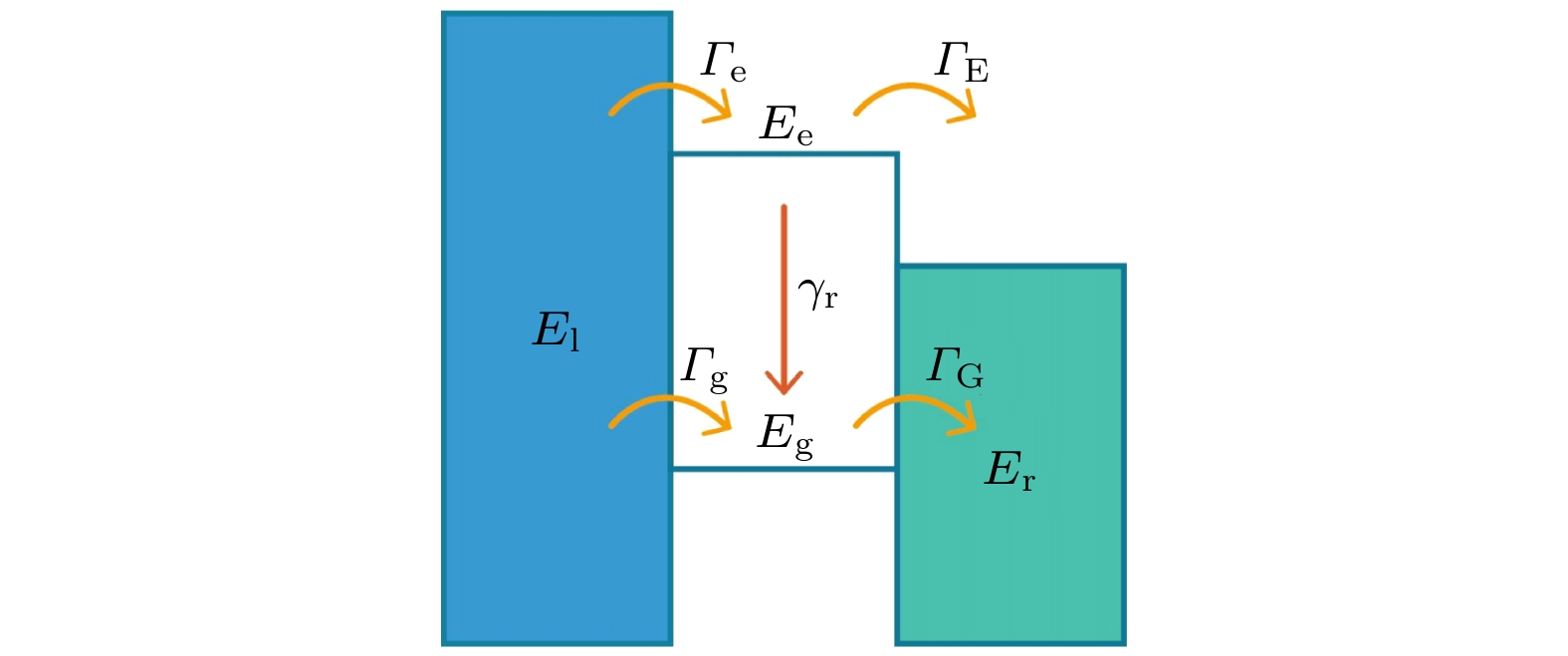
2023, 72 (4): 047301.
doi:10.7498/aps.72.20222159
Abstract +
We theoretically study the quantum speed limit (QSL) of the single dot system in dissipative environment based on quantum dot transport theory and Bures angle metric method. The theoretical results show that in the dissipative environment, different tunneling probabilities have different effects. The increase of left tunneling probability has a weak effect on the accelerating capability of the system, due to the Coulomb blocking effect and quantum coherence. On the other hand, the right tunneling probability has a significant influence on the accelerating capability of the system, the accelerating capability is promoted with the increase of right tunneling probability because of the effect of channel blocking and co-tunneling. The increase of energy displacement promotes the accelerating capability of the system and changes the oscillation frequency of the system, owing to its taking longer time for the system to evolve to a target state. The effect of the relaxation rate for the system's accelerating capability is not monotonic, there is an interesting turning point due to the change of electron layout number. When the relaxation rate is less than this point, the accelerating capability of the system will oscillate. When the relaxation rate is higher than this point, the change of accelerating capability is monotonically suppressed by the relaxation rate. In general, the increase of the relaxation rate weakens the acceleration capability of the system. Our results provide theoretical reference for studying the QSL time in a semiconductor device affected by numerous factors.

2023, 72 (4): 047401.
doi:10.7498/aps.72.20222091
Abstract +
Rydberg atom can respond to weak microwave electric field signal in real-time by using its electromagnetically induced transparency effect to realize down conversion of space microwave electric field signal, which can be used as a superheterodyne receiver. The Rydberg atom superheterodyne receiver is a new receiving system composed of Rydberg atoms, photodetectors, and electronic information processing modules. Presently, the physical response mechanism of Rydberg atomic superheterodyne receiving technology is studied in depth. However, no complete receiving link analysis model has been established, which is not conducive to optimizing its system performance. Based on the physical mechanism of the Rydberg atom responding to the microwave electric field, this paper introduces the concept of intrinsic expansion coefficient, establishes and experimentally verifies the receiving link model of the Rydberg atom superheterodyne receiver, and briefly discusses the influence of the intrinsic expansion coefficient on the system sensitivity and response characteristics, thereby providing the theoretical guidance for optimizing the performance of the Rydberg atom superheterodyne receiving system. In the end, the Rydberg atomic and the electronic receiving links' sensitivity performance is discussed and compared.

2023, 72 (4): 047801.
doi:10.7498/aps.72.20221548
Abstract +
In this work, the conductivity of intrinsic GaSe, S doped 2.5 mass% GaSe (GaSe: S(2.5%)), and S doped 7 mass% GaSe (GaSe: S(7%)) crystals, in a frequency range of 0.3–2.5 THz, is measured by transmission terahertz time-domain spectroscopy, and fitted with Drude-Smith-Lorentz model which is introduced by lattice vibration effect. It is found that the real part of conductivity decreases with the augment of S doping, which is caused by the gradual shift of the Fermi energy level of GaSe crystals to the charge neutrality level due to the generation of substitution impurities and gap impurities by S doping, resulting in the reduction of carrier concentration. The intrinsic GaSe and GaSe: S(2.5%) have a clear lattice vibration peak at about 0.56 THz, while GaSe: S(7%) has no lattice vibration peak near 0.56 THz, which is mainly due to the S doping increasing the structural hardness of the crystal and reducing the interlayer rigidity vibration of the crystal. All three samples have the obvious narrow lattice vibration peaks at about 1.81 THz, and the intensities that first decrease and then increase with the augment of S doping, which is mainly due to the fact that a small amount of S doping can reduce the local structural defects of GaSe and weaken the intensity of the narrow lattice vibration peak, while excessive S doping can generate the β-type GaS crystal, increase the local structural defects of the crystals and the intensity of the narrow lattice vibration peak. With the increase of S doping, the intensity of the broad lattice vibration peak of GaSe crystal weakens or even disappears at about 1.07 THz and 2.28 THz, mainly due to the S doping resulting in the substitution of S for impurities and GaS gap impurities, which reduces the fundamental frequency phonon vibration intensity, thereby weakening the lattice vibration caused by the second-order phonon difference mode of the crystal. The results show that the appropriate concentration of S doping can effectively suppress the lattice vibration of GaSe crystal and reduce the conductivity and power loss in the THz band. This study provides important data support and theoretical basis for the design and fabrication of low loss THz devices.
INTERDISCIPLINARY PHYSICS AND RELATED AREAS OF SCIENCE AND TECHNOLOGY
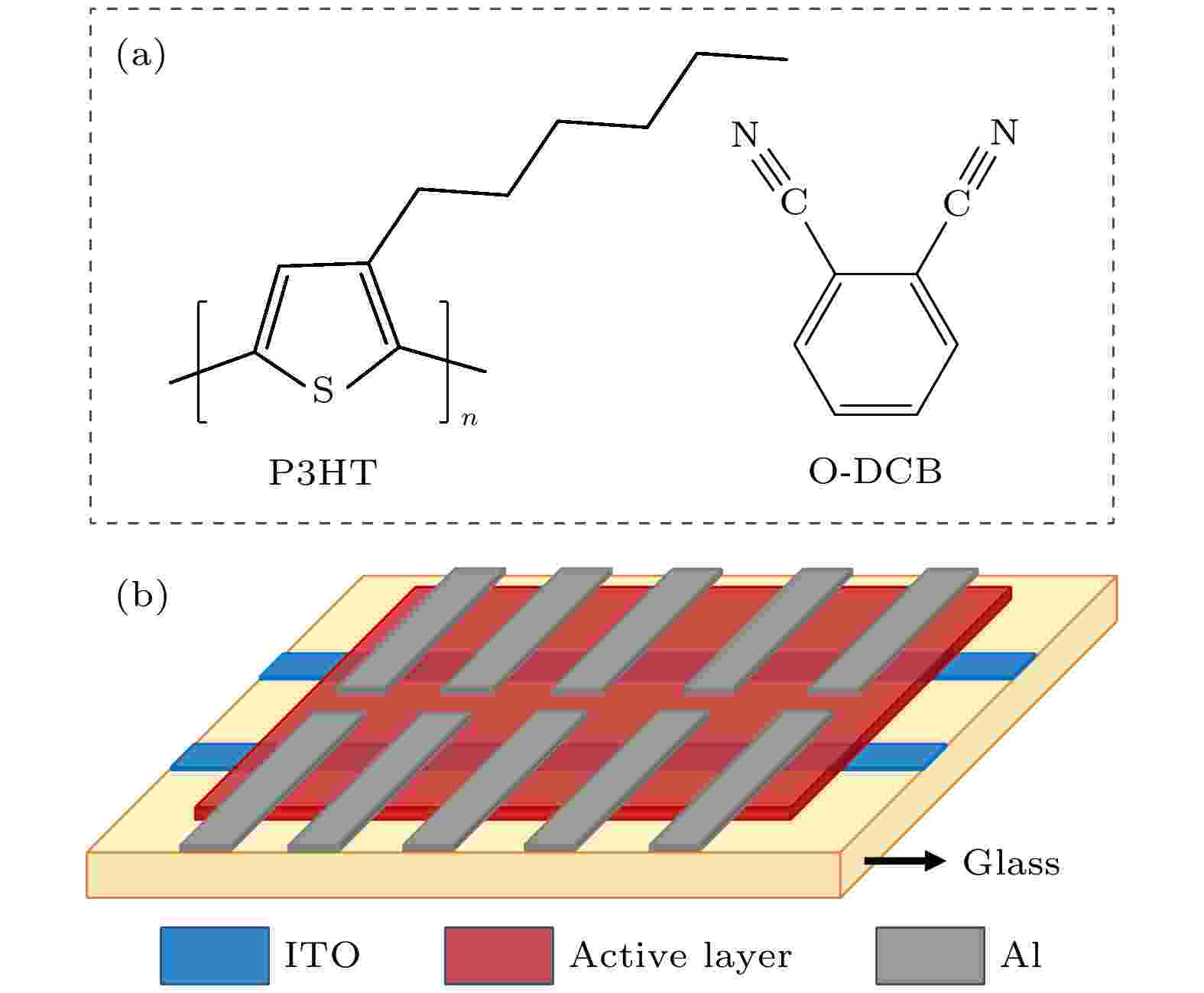
2023, 72 (4): 048501.
doi:10.7498/aps.72.20221507
Abstract +
As the emerging data storage technology, organic resistive switching memory (ORSM) possesses numerous superiorities as the substitution for or the complementation of the traditional Si-based semiconductor memory. Poly(3-hexylthiophene) (P3HT) has been widely used as a polymer donor component of ORSMs due to its advantages of high mobility and high chemical stability. Up to now, ORSM based on P3HT has achieved high on/off current ratio (Ion/off), but the endurance still needs to be improved. Herein, high endurance ORSMs based on 1,2-dicyanobenzene (O-DCB) and P3HT composite are fabricated by spin coating and thermally evaporating, and exhibit non-volatile and bipolar memory characteristics. The ORSMs based on P3HT:15 wt.% O-DCB and P3HT:30 wt.% O-DCB exhibit the values ofIon/offexceeding 104and 103respectively, and both of them exert excellent endurance of 400 times, retention time of more than 105s. The mechanism of the switching is explored by linear fitting ofI-Vcurve and electrochemical impedance spectrum . The results indicate that the filling and vacant process of the charge traps induced by O-DCB and the inherent traps in P3HT bulk lead to a resistive switching effect. The negative or positive bias triggers off trapping and detrapping process, which leads the conductive way of charges to change, resulting in the resistive switching effect. The excellent endurance of ORSM is attributed to the uniform distribution of O-DCB in P3HT bulk because of the small molecular size and high solubility of O-DCB, resulting in well-distributed and stable charge traps. On the other hand, the out-bound planarity of O-DCB molecular promotes the close interaction with the conjugated chains of P3HT. This study enlightens an effective strategy to carry out high-endurance ORSM and facilitates their electronic applications in future.
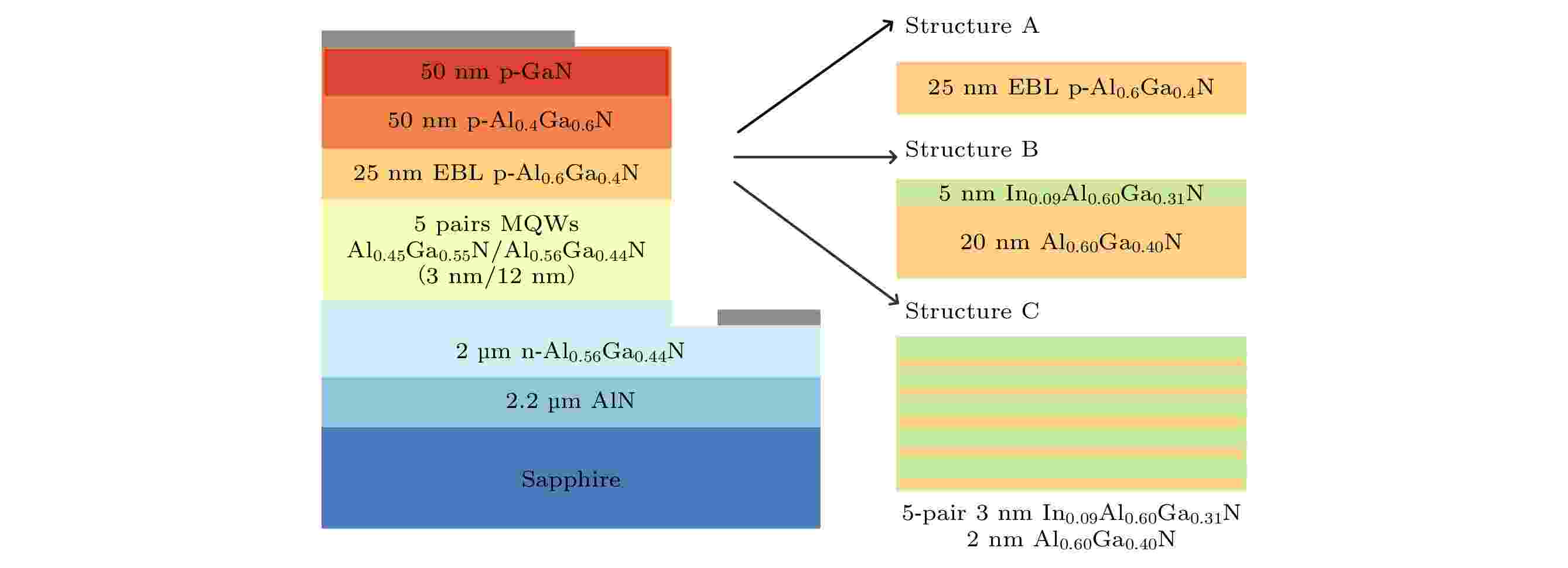
2023, 72 (4): 048502.
doi:10.7498/aps.72.20222004
Abstract +
AlGaN-based deep-ultraviolet light-emitting diodes (DUV LEDs) are widely used in sterilization, sensing, water purification, medical treatment, non-line of sight (NLOS) communication and many other fields. Especially it has been reported that the global novel coronavirus (COVID-19) can be effectively inactivated by the DUV light with a wavelength below 280 nm (UVC) within a few seconds, which has also attracted great attention. However, the external quantum efficiency (EQE) of UVC LED is still at a low level, generally not more than 10%. As an important component of EQE, internal quantum efficiency (IQE) plays a crucial role in realizing high-performance DUV-LED. In order to improve the IQE of AlGaN-based DUV-LED, this work adopts an electron blocking layer (EBL) structure based on InAlGaN/AlGaN superlattice. The results show that the superlattice EBL structure can effectively improve the IQE compared with the traditional single-layer and double-layer EBL structure for the DUV-LED. On this basis, the optimization method based on JAYA intelligent algorithm for LED structure design is proposed in this work. Using the proposed design method, the InAlGaN/AlGaN superlattice EBL structure is further optimized to maximize the LED’s IQE. It is demonstrated that the optimized superlattice EBL structure is beneficial to not only the suppression of electron leakage but also the improvement of hole injection, leading to the increase of carrier recombination in the active region. As a result, the IQE of the DUV-LED at 200 mA injection current is 41.2% higher than that of the single-layer EBL structure. In addition, the optimized structure reduces IQE at high current from 25% to 4%. The optimization method based on intelligent algorithm can break through the limitation of the current LED structure design and provide a new method to improve the efficiency of AlGaN-based DUV-LED.
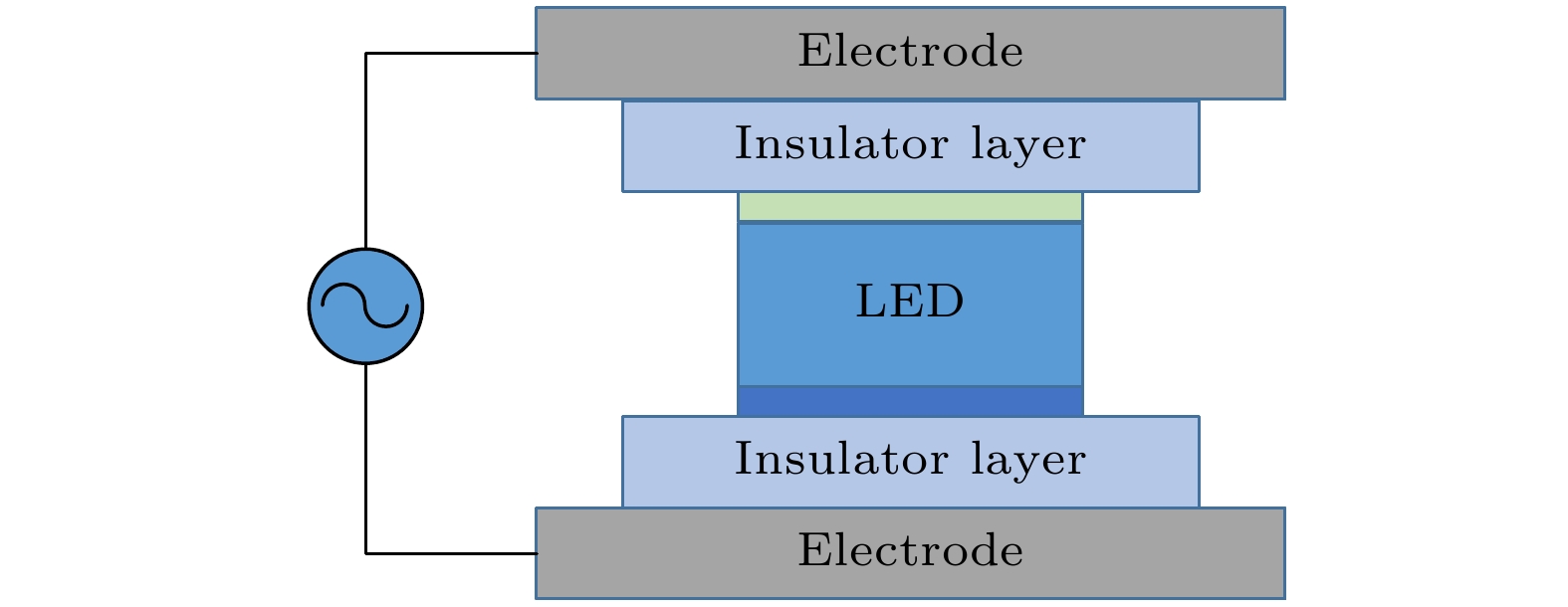
2023, 72 (4): 048503.
doi:10.7498/aps.72.20221831
Abstract +
Non-carrier-injection light-emitting diodes (NCI-LEDs) are expected to be widely used in the next-generation micro-display technologies, including Micro-LEDs and nano-pixel light-emitting displays due to their simple device structures. However, because there is no external charge carrier injection, the internal carrier transport behavior of the NCI-LED cannot be described by using the traditional PN junction and LED theory. Therefore, establishing a carrier-transport model for the NCI-LED is of great significance in understanding its working mechanism and improving device performance. In this work, carrier transport mathematical model of the NCI-LED is established and the mechanical behavior of charge-carrier transport is analyzed quantitatively. Based on the mathematical model, the working mechanism of the NCI-LED is explained, the carrier transport characteristics of the device are obtained. Additionally, the key features, including the length of the induced charge region, the forward biased voltage across the internal PN junction, and the reverse biased voltage across the internal PN junction are studied. Their relationships with the applied frequency of the applied driving voltage are revealed. It is found that both the forward bias and reverse bias of the internal PN junction increase with the driving frequency. When the driving frequency reaches a certain value, the forward bias and the reverse bias of the PN junction will be maintained at a maximum value. Moreover, the length of the induced charge region decreases with the increase of the driving frequency, and when the frequency reaches a certain value, the induced charge region will always be in the state of exhaustion. According to the mathematical model, suggestions for the device optimization design are provided below. 1) Reducing the doping concentration of the induced charge region can effectively increase the voltage drop across the internal LED; 2) employing the tunneling effect occurring in the reverse-biased PN junction can effectively improve the electroluminescence intensity; 3) using the square-wave driving voltage can obtain a larger voltage drop across the internal LED and increase the electroluminescence intensity. This work on the carrier transport model is expected to e present a clear physical figure for understanding the working mechanism of NCI-LED, and to provide a theoretical guidance for optimizing the device structure.
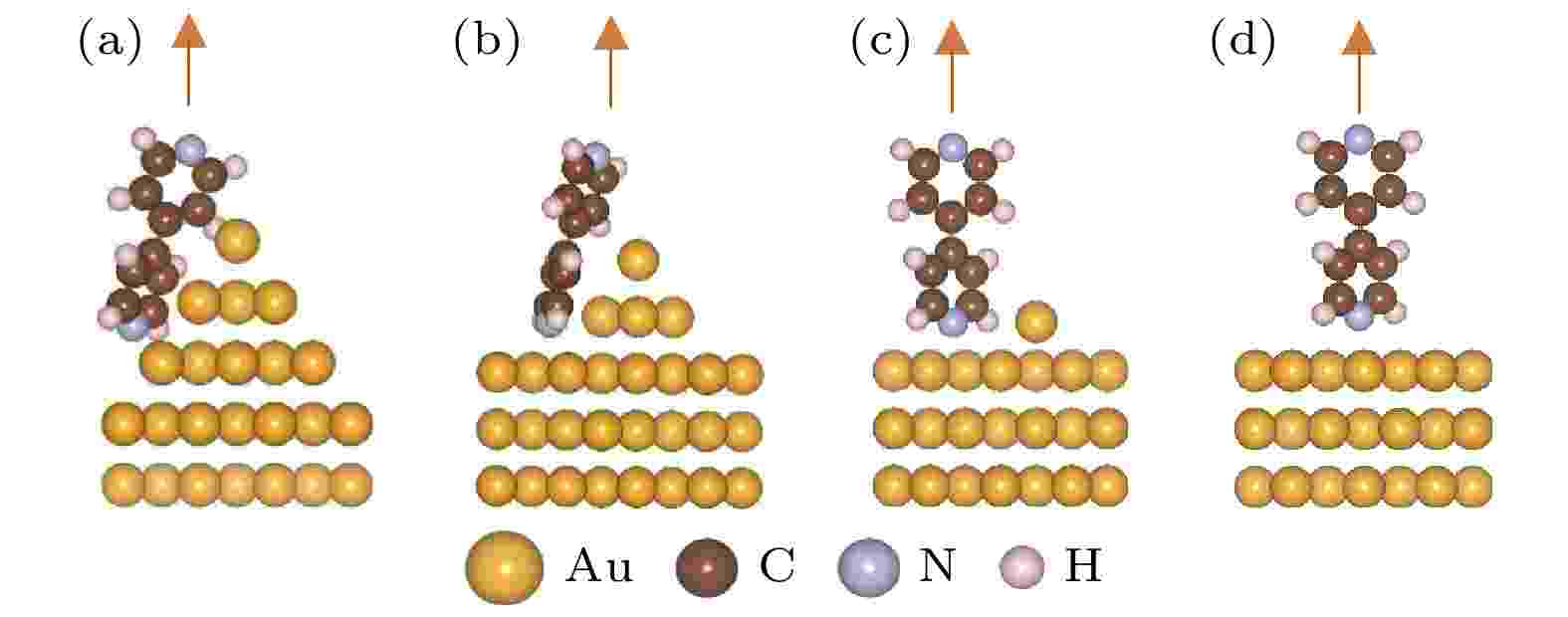
2023, 72 (4): 048504.
doi:10.7498/aps.72.20222081
Abstract +
Pyridyl-ended molecular junctions show high and low breaking forces successively in formation process and at the same time exhibit intriguing conductance switching behaviors. To understand the forming process of pyridyl-ended molecular junctions, the interaction between 4,4′-bipyridine molecule and gold electrode is studied by theab initio-based adiabatic simulation method. The processes that the molecule moves away from electrode tip with different contact configurations are simulated, and the molecule-electrode interface evolutions, energy of the molecule-electrode system and the force between molecules and electrode are calculated in the simulations. The numerical results show that during the molecule moving away from the pyramid-shaped electrode, the pyridyl is easy to vertically adsorb on the second gold layer of the electrode tip. In this contact configurations, the tip Au atom deviates from the original position due to the lateral pushing force of the pyridyl. It needs about 1.3–1.5 nN stretching force for the pyridyl breaking from the second gold layer and switching to the tip Au atom, which is evidently larger than the force of 0.8–1.0 nN for the molecule breaking from the tip Au atom. This result is well consistent with the experimental observations, which thus reveals the relationship between the interface structures and the stretching force in the formation process of bipyridyl molecular junction in the experiment. The interaction between 4,4′-bipyridine molecule and plane-shaped gold electrode is very weak. It needs no more than 0.5 nN for the molecule breaking from the plane-shaped gold electrode. However, when the molecule adsorbs on the single Au atom which is adsorbed on the surface of plane-shaped electrode, the molecule can sustain 1.7 nN stretching force. Our study shows that theab initio-based adiabatic stretching simulation method can not only reveal the geometric evolution process of molecule-electrode systems, but also identify the specific contact configurations between molecule and electrode.
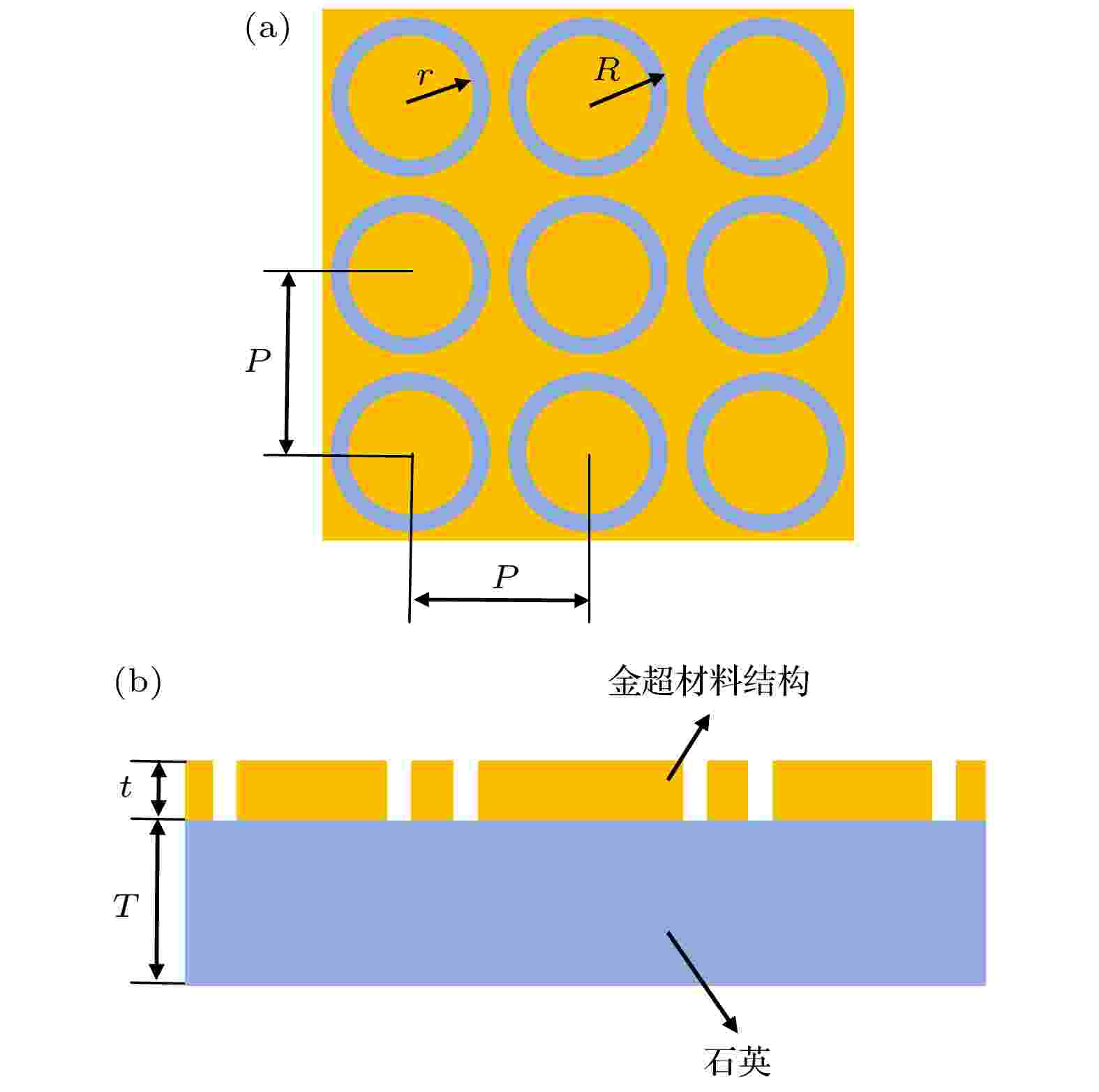
2023, 72 (4): 048701.
doi:10.7498/aps.72.20221174
Abstract +
In order to improve the detection performance of 0.1–1THz terahertz wave, a new lithium tantalate pyroelectric terahertz detector based on ring hole array metamaterial is proposed. The quantitative influences of the characteristic parameters such as inner diameter, outer diameter, period and thickness on the transmission bandwidth and transmittance of ring hole array metamaterials are analyzed by simulation. The mechanisms of the influences of different combinations of ring hole array metamaterials and pyroelectric detectors on the detection bandwidth and detection rate of terahertz waves are clarified. The lithium tantalate pyroelectric terahertz detectors of the ring hole array metamaterial ware are fabricated by the MEMS technology. The transmission of the ring hole array metamaterial and the noise equivalent power of the metamaterial detector at different frequencies are tested. The results show that the transmittance of the fabricated ring hole array metamaterial is greater than 40% at 0.25–0.65 THz, and bandpass filtering is realized. When the ring hole array metamaterial and the pyroelectric detector maintain a sufficient distance, the noise equivalent power of the detector at 0.315 THz is 11.29 μW/Hz0.5, which is 6.3% of the 0.1 THz noise equivalent power (outside the bandpass band), so the bandpass detection is achieved. When the ring hole array metamaterial is attached to the detector, the noise equivalent power of the metamaterial detector at 0.315 THz is 4.64 μW/Hz0.5, which is 29.4% that of the detector without the ring hole array metamaterial, so the narrowband detection is achieved. The above conclusions show that the pyroelectric terahertz detector based on the ring hole array metamaterial can realize the bandpass and narrowband detection of specific frequency band in applications such as biological imaging and macromolecular detection.

2023, 72 (4): 048901.
doi:10.7498/aps.72.20221878
Abstract +
In the study of complex networks, researchers have long focused on the identification of influencing nodes. Based on topological information, several quantitative methods of determining the importance of nodes are proposed. K-shell is an efficient way to find potentially affected nodes. However, the K-shell overemphasizes the influence of the location of the central nodebut ignores the effect of the force of the nodes located at the periphery of the network. Furthermore, the topology of real networks is complex, which makes the computation of the K-shell problem for large scale-free networks extremely difficult. In order to avoid ignoring the contribution of any node in the network to the propagation, this work proposes an improved method based on the iteration factor and information entropy to estimate the propagation capability of each layer of nodes. This method not only achieves the accuracy of node ordering, but also effectively avoids the phenomenon of rich clubs. To evaluate the performance of this method, the SIR model is used to simulate the propagation efficiency of each node, and the algorithm is compared with other algorithms. Experimental results show that this method has better performance than other methods and is suitable for large-scale networks.
GEOPHYSICS, ASTRONOMY, AND ASTROPHYSICS
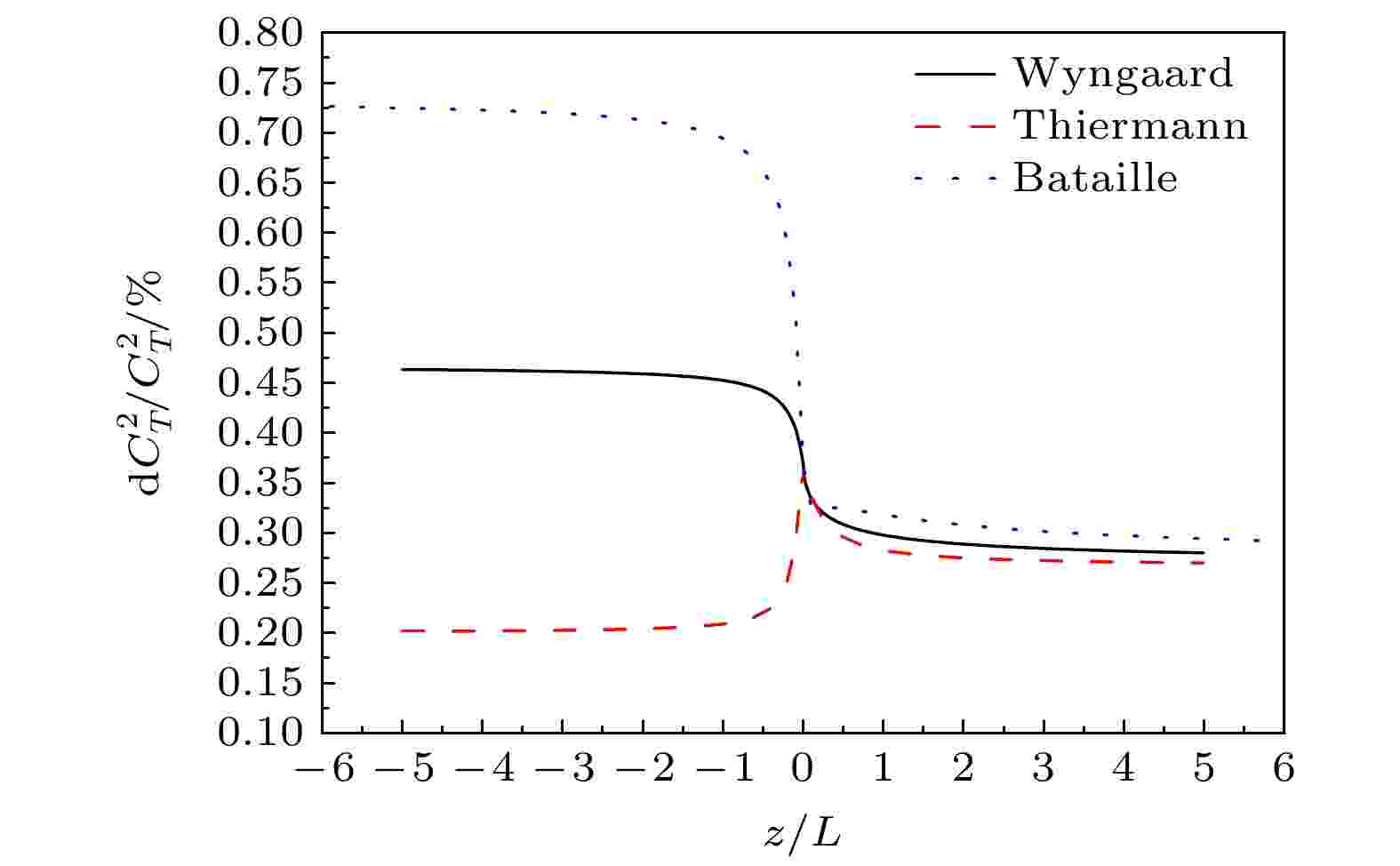
EDITOR'S SUGGESTION
2023, 72 (4): 049201.
doi:10.7498/aps.72.20221986
Abstract +
Stratification is a significant characteristic of atmospheric turbulence, especially high-altitude turbulence. At a fixed height, the real optical turbulence value fluctuates by 1–2 orders of magnitude or even greater on the average value. The turbulence profile model based on the observed data is a statistical average result. It can neither represent the stratification characteristics of an actual atmospheric turbulence profile nor have the prediction function, and can not fully meet the demand of optical engineering. Owing to the limitation of the capacity and speed of the computer, it is impossible to solve the Navier Stokes equation through direct numerical simulation (DNS) and large eddy simulation (LES) to predict the optical turbulence. The solution is to predict the conventional gas parameters through the mesoscale weather numerical prediction model MM5/ WRF, and then calculate the turbulence parameters through the turbulence parameterization scheme. In this paper, the prediction methods and research results of
$ C_n^2 $
in surface layer,boundary layer and free atmosphere layer are introduced. Tatarski formula is derived in detail from the turbulence kinetic energy prediction equation and the temperature fluctuation variance prediction equation, and the physical meaning and applicable conditions of the formula are summarized. The latest research progress of neural network prediction and Antarctic astronomical site selection is mainly introduced. The characteristics and differences among different models, such as the empirical model fitted with experimental data, the parameter model with conventional meteorological parameters based on Kolmogorov turbulence theory, the prediction model related to mesoscale meteorological model, and the neural network method based on data driving and so on, are analyzed. It is emphasized that Kolmogorov turbulence theory is the theoretical basis of the existing atmospheric optical turbulence parameter models.
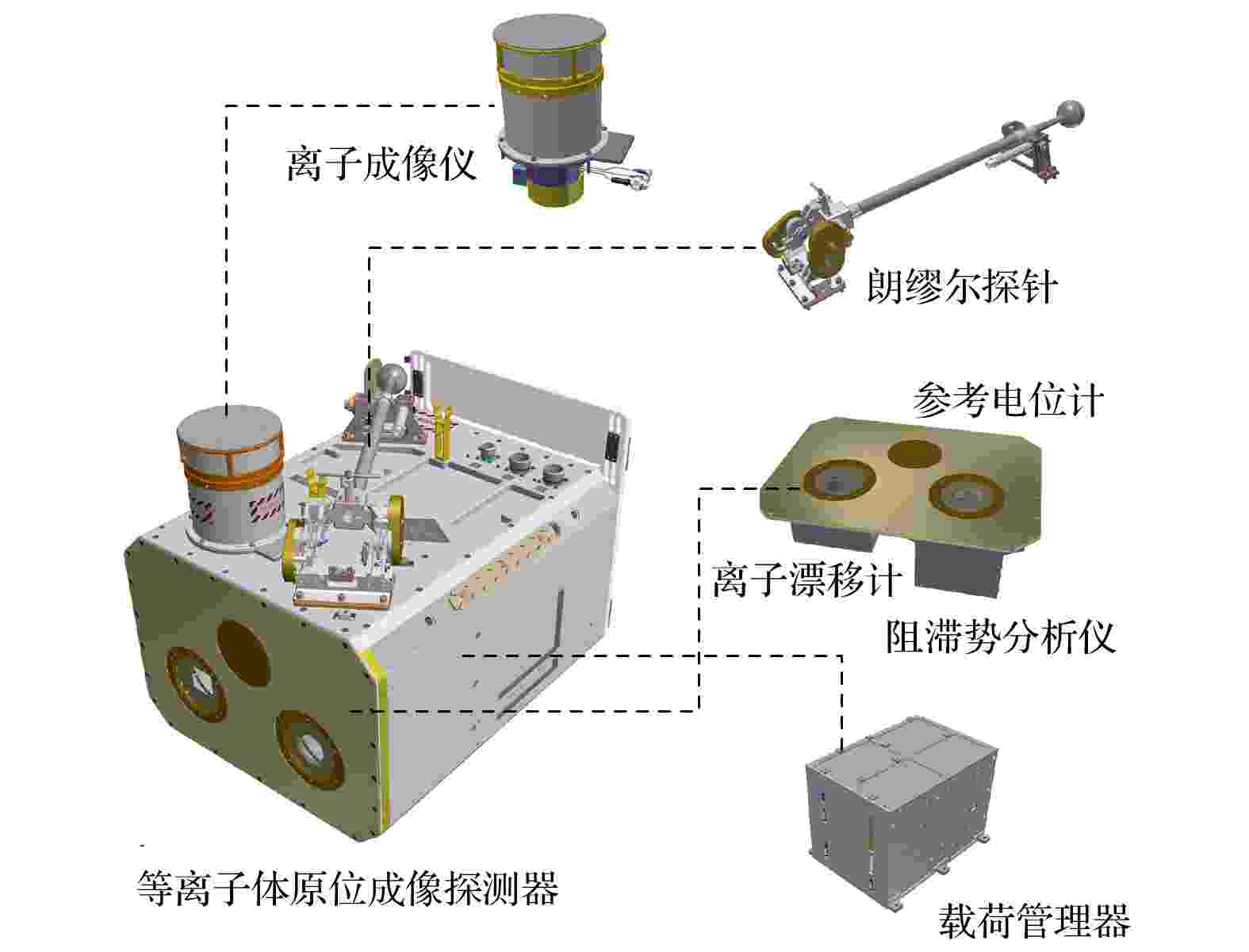
2023, 72 (4): 049401.
doi:10.7498/aps.72.20221759
Abstract +
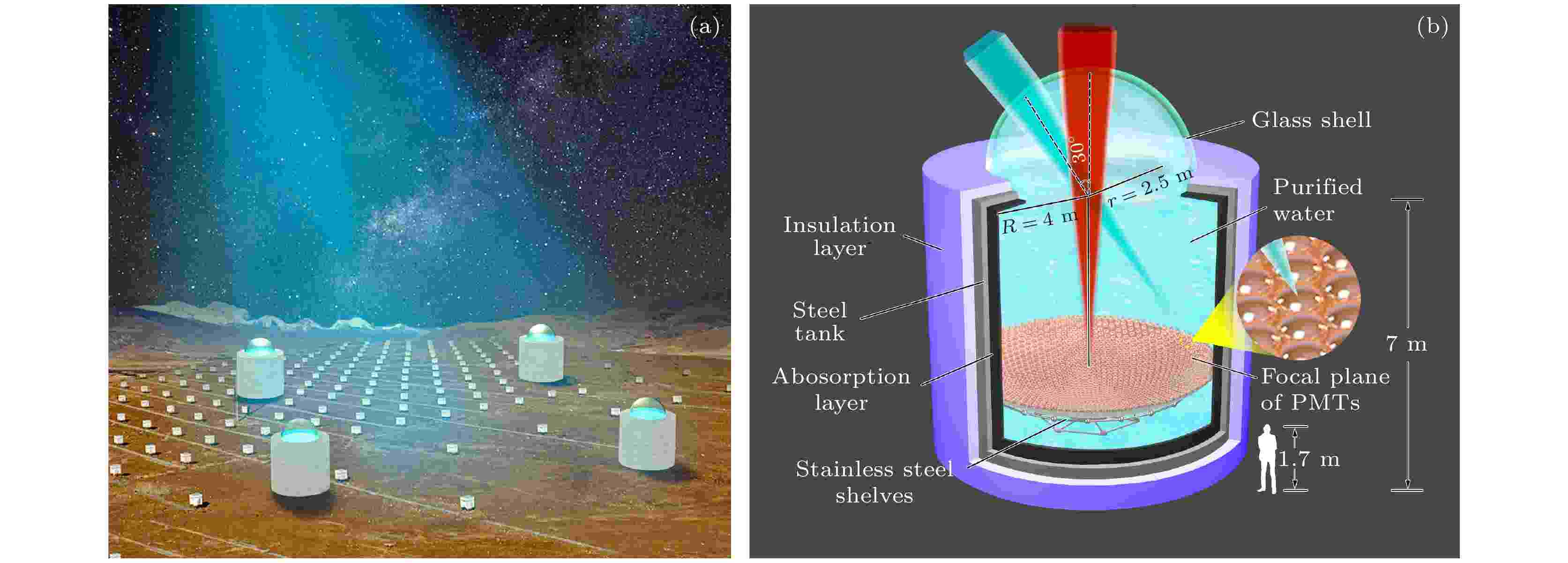
COVER ARTICLE
2023, 72 (4): 049501.
doi:10.7498/aps.72.20221976
Abstract +
The High Altitude Detection of Astronomical Radiation (HADAR) experiment is a refracting terrestrial telescope array based on the atmospheric Cherenkov imaging technique. It is a hybrid array consisting of four water-lens telescopes and a surrounding scintillation detector array for observing Cherenkov light induced by 10 GeV–10 TeV cosmic rays and gamma rays in the atmosphere. The water-lens telescope mainly consists of a hemispherical lens with a diameter of 5 m acting as a Cherenkov light collector, a cylindrical metal tank with a 4 m radius and 7 m height, and an imaging system at the bottom of the tank. The sky region covered by HADAR is much larger than the current generation of Imaging Atmospheric Cherenkov Telescopes, and even the CTA. The field-of-view (FOV) of HADAR can reach up to 60 degrees. The HADAR experiment possesses the advantages of a large field-of-view and low energy threshold, so it can continuously scan wide portions of the sky and easily observe extragalactic gamma-ray sources. The majority of the extragalactic gamma-ray sources detected at very high energy (VHE) energies are active galactic nuclei (AGNs). In this study, we present the potential of using the HADAR experiment for detecting AGN. Based on the AGN catalog sources of the Fermi Large Area Telescope (Fermi-LAT), the observed energy is extrapolated to the VHE range. The VHE gamma rays propagating over cosmological distances can interact with the low-energy of the extragalactic background light (EBL) and produce electron-positron pairs. Therefore, we consider the absorption effects of different EBL models when calculating the expected gamma ray spectra of the AGN sample. We select the sample with redshift measurements and locations inside the FOV of HADAR from 4LAC catalog. In total, there are 375 BL Lacertae objects (BL Lacs) and 289 flat-spectrum radio quasars (FSRQs) satisfying the selection conditions. The integral gamma ray spectra are derived and compared with the sensitivity curve of HADAR, the number of sources with fluxes above the sensitivity of HADAR is counted. Further, we calculate the statistical significance of HADAR for AGN source observation based on the equi-zenith angle sky scanning analysis method. The simulation results reveal that a total of 31 sources of Fermi-LAT AGN can be detected by HADAR with a significance greater than five standard deviations over a one-year survey period, most of which are BL Lacs.

2023, 72 (4): 049502.
doi:10.7498/aps.72.20222119
Abstract +
Gravitational wave detection plays an important role in exploring the universe and opening up a new chapter for multi-messenger astronomy. As the most common device used for space and ground-based gravitational wave detection, large-scale laser interferometer requires a low-noise laser as a beam source. The noise of the laser can be suppressed by utilizing the optoelectronic negative-feedback noise reduction technology to improve the sensitivity of large-scale laser interferometer. The optoelectronic negative-feedback control system can suppress laser noise by subtracting the photodetector signal from the voltage reference signal, and then calculating the modulated signal by a proportional integral differentiator to control the output power of the pump current driver. Since the photodetector signal is affected by the laser intensity, its output voltage varies within a certain range, which requires that the output voltage of the voltage reference source signal is variable. In addition, the performance of the voltage reference directly affects the overall performance of the feedback control loop, therefore it is the lower limit of laser noise suppression. We develop a high-precision low-noise program-controlled voltage reference by selecting low-noise reference chip and digital-to-analog conversion chip, designing external control circuit, using low-temperature drift coefficient components and using temperature control and electromagnetic shielding. The digital-to-analog conversion is controlled through the FPGA module programming to accurately realize the reference voltage change. The output voltage range of the developed voltage reference source is from negative 10 V to positive 10 V and the minimal precision of the voltage variation is 20 bit. The voltage noise spectral density of the developed voltage reference is below
$9.6 \times 1{0^{ - 6}}/\sqrt {\rm Hz}$
and the noise performance of the reference source is less than the laser intensity noise in the space-based gravitational wave frequency band. The developed voltage reference source provides an important technical support for laser intensity noise suppression in gravitational wave detection.













